

| Family
History Links: |
Enns History |
Fehr History |
Guenther History | Thiessen History | |||
| Family
Tree Links: |
Diagram (SVG) | WebTrees (Online App) | Gedcom ToHTML (HTML Database) |
Chart (Simple HTML) | DNA
Ancestry |
||
| Emmigration
Ship Links: |
SS Quebec (Enns/Unger/Hoeppner/Reimer) | SS Sarmatian (Fehr/Wiens) | SS Sardinian (Ginter) | SS Canadian (Thiessen/Ham/Wolfe) | SS Polynesian (Janzen/Penner) | SS Peruvian (Ginter/Wiebe) | The Journey |
| Deed/Map
Links: |
Land Grant Deeds | Maps | |||||
| Miscellaneous: |
Bible Registers |
Hoeppner
Homestead |
Dedication |
East Frisia around 1600,
drawn by Ubbo Emmius
|
|
According to the family bible account
(shown below), Franz Enns traveled from Prussia to
Russia in 1797 (when he was 1 year old) with his
parents. This would suggest that they were part
of the following migration: A group of 118
families immigrated from Germany in 1797. Because they
did not have enough crown land, the government bought
a parcel of land from Noble Miklaschevsky. In 1803
they first built Burwalde and Nieder-Chortitza on this
parcel. In 1809 they founded Kronsthal and in 1812,
Neu-Osterwick (today known as Osterwick). [Osterwick,
Chortitza Colony, Russia Village Report - 1942] In the years of 1793
- 1796 still more Mennonites arrived from Prussia.
Altogether 118 families, of which most of them settled
in the Chortizan colonies. Because of lack of
room, the rest were quartered in the town
Alexandrowsk. These new arrivals were called the
second emigration. Because of their own money
and some German cattle stock they brought with them in
addition to receiving support money, the
original community was livened. The community also
happily received an advance of 1600 ruble per
family, to enhance their growth. That contributed to
the erection of the first wooden prayer house.
In 1797, under supervision of Mr. Brigonzi , the last
of the 118 families were settled. 86 families
built their homes in the Chortizan colony and 32
families founded two new colonies. [Chortiza
- 1848 Village History] [The following is an excerpt from the
book A Canadian Story
by Gary W. Strahl, with permission from the
author] In 1823 Jakob married Susanna Harder, who had been born in Prussia in 1797, and had come with her parents to Russia as a newborn baby. Initially they lived in the Chortiza colony where they had grown up, but later they moved to the Bergthal Colony that was established in 1836. Jakob and Susanna (Harder) Enns had seven children, two of who died as infants. No information is available on any of these children except for the youngest, Franz, who was born in 1845. It is his story that we will follow next. Jakob died in Russia in 1863 at the age of 67, and Susanna died there in 1872 at the age of 75. Franz Enns was born on May 24, 1845 to Jakob and Susanna Enns in South Russia. He was educated in a private German school. it is believed that he was an ardent student, as some of his German handwritten dccuments would indicate. Franz Enns was baptised and became a member of the church in 1866. In this same group was Justina Unger, who was soon to become his bride. They were married on August 2, 1866. Justina's birthdate was January 3, 1847. It is believed that Franz Enns and Justina Unger met and started their courtship when Justina was working on the neighboring farm to the Enns's as a maid (Knackshi). Franz and Justina Enns started their first years of marriage with quite a struggle as economic conditions changed dramatically and land was not easily obtained. They built their house, called an "Erd Semlin", or a house built of mud blocks and pole rafters, with a sod roof, thatched with tall grass that grew in the lower swamp lands. This first home was built in the side of a hill, which sometimes created problems in the winter when snow would keep blowing into the entrance. A string from the house to the barn would serve as a guide during a severe winter storm. Some of the more established Mennonites, with land already in their possession, had become outstanding people who were operating their own flour and feed grinding mills, blacksmith shops, raising grains, cattle and large gardens. Approximately one-third fo the Mennonite population were landless squatters (Anwohner) and working for the wealthier farmers. This was also the case of the Franz Ennses. Their house had been built on a river bank which was crown land. Their first child, Helena, was born here. In the spring of 1869 they were able to purchase an acreage consisting of seven acres, a house constructed of wood and a barn. They were now able to keep a few head of cattle and had a large garden. They also built a shop where neighbours would have their harnesses repaired. This became a career for Franz Enns and helped greatly with their livelihood. In 1876 Franz and Justina joined those Mennonites dissatisfied with the Russian government who decided to move to North America. Franz and Justian sold those possessions that they could not take with them. Their land and house were sold to a neighbor who let them stay until they were ready to leave for Canada. They began their overland journey to Hamburg in early May 1876 with their five children all under the age of eight; Helena (b. 1869), Franz (b. 1870), Heinrich (b. 1871), Gerhard (b. 1873) and Justina (b. 1875). Before they reached Liverpool, England, their sixth child, Anna, was born on May 21, 1876. In mid-June the Enns family boarded the S.S.Quebec No. 22 in Liverpool for the approximately ten-day voyage to Quebec City. All told, there were 33 Mennonite families on board, totalling 225 persons. The group leaders were Franz Froese and David Giesbrecht. It was between Liverpool and Quebec that one-year old Justina suddenly became ill and died within hours. She was placed in a makeshift wooden coffin and buried at sea. On June 23, 1876 the ship docked at Quebec City. The group now travelled by train to Collingwood, Ontario. Here they embardked on a lake barge which transported them across Lakes Huron and Superior to Duluth, Minnesota. There they took a train to Moorehead, on the Red River, where they switched to a paddle wheeler. The trip to Canada down the Red River took about three days. At the junction of the Red and Rat Rivers, the settlers disembarked and walked to the immigration sheds, five miles to the east. Although they had finally arrived in Canada after two months of travel, the journey was not yet over. Most of the group was destined for the West Reserve, which required a further journey of 50 miles. By July 20, 1876 the Franz Enns family had arrived at the village of Eichenfeld, ten miles south of Morden, Manitoba. Franz and Justina had three children born to them in Canada; Jacob (b. 1878), Abraham (b. 1880) and Maria (b. 1883). Their first-born daughter Helena (b. 1869), however, died before 1881, not having reached the age of 13. In April 1883 Franz Enns become a naturalized British subject. He and all his family were now Canadian citizens. This detail becomes important later in our story. For
two years the Enns family lived in the village of
Eichenfeld, and then in 1878 Franz built a 20x28
house and a 20x12 stable on SW
14-T1-R5W. On
September 17, 1879 he formally entered a homestead
on this quarter section, and by April 1883 he had 45
acres in crop. On May 11, 1886 Franz was granted
title to his land. Franz was 56 years old when he
died on July 22, 1901. His wife Justina died in 1909
at the age of 62. [A
Canadian Story by Gary W. Strahl (Pages 63-65)] Franz Enns is also mentioned in an
article with his wife Justina: Franz Ens (May 28, 1845 - 1901) (der
Grosse?) |
|
|
Patronymic, based on a common German first name; "gund" =
battle + "heri" = army, hence "warrior in battle" or
"defender". The name is common in all
German-speaking lands, and was also used in early
Anglo-Saxon England. In the Doomsday Book (11
century) names like Gonther and Gunter are listed as
tenants. The name was introduced into Mennonite
congregations in West Prussia by converts. According
to Stumpp 7 Günther/Ginter families emigrated from West
Prussia to Russia. [Mennonite Names,
Victor Peters/Jack Thiessen, 1987 M 929.4 page 66] Where does the Name Guenther come from?
|
|
|
There
are a few different ways to view my family tree
information of 2400+ individuals:
|
| Abram Enns 1880-1966 1891 Census 1901 Census 1906 Census 1911 Census 1921 Census 1 1921 Census 2 Marriage |
Elizabeth Hoeppner 1881-1945 1891 Census 1901 Census 1906 Census 1911 Census 1921 Census 1 1921 Census 2 Marriage |
David Fehr 1871-1947 1891 Census 1901 Census 1906 Census 1916 Census 1911 Census? 1921 Census 1 1921 Census 2 SS Sarmatian Marriage |
Elizabeth Janzen 1879-1958 1891 Census 1901 Census 1906 Census 1916 Census 1921 Census 1 1921 Census 2 Marriage |
Jacob Ginter 1865-1927 1891 Census 1901 Census 1906 Census 1911 Census 1916 Census 1921 Census 1 1921 Census 2 SS Peruvian Marriage? Death |
Anna
Thiessen 1874-1951 1901 Census 1906 Census 1911 Census 1916 Census 1921 Census 1 1921 Census 2 Marriage? |
Diedrich Thiessen 1890-1975 1891 Census 1901 Census 1906 Census 1911 Census 1921 Census 1 1921 Census 2 Marriage |
Maria Ginter 1896-1930 1901 Census 1921 Census 1 1921 Census 2 Marriage Death |
| John Enns 1906-1981 1911 Census Birth |
Helena Fehr 1909-1999 1911 Census Birth |
Henry Guenther 1910-1996 1911 Census 1916 Census Birth |
Anna Thiessen 1917-2015 1921 Census |
| Jacob
Enns 1939-2004 |
Catherina Guenther 1941- |
| Darren
Enns 1962- |
Brenda Enns 1963- |
Richard Enns 1965- |
|
My GEDCOM was edited and cleaned up by
another Linux program called FTree written
by Clive Stubbings. Much thanks go to:
Two other good online sources of Canadian mennonite church memberships from www.mennonitegenealogy.com (MMHS) are:
http://www.wikitree.com/ Helpful Census and Record links:
A very useful online tool for checking GEDCOM integrity
is Bonkers:
The GEDCOM Sanity Checker! For interest, here is a graph showing just my own
personal direct ancestry tree: Here is my Webtrees personal 5-generation ancestry:
4 wiebe In other words, I am more
'Wiebe' and 'Penner' than I am 'Enns' :) |
As a bold new experiment in my genealogical
research, I have dabbled with DNA genealogy! 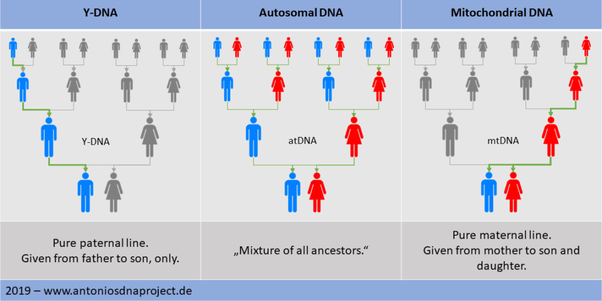
An older article by Glen Klassen also provides some
useful information: |
 Note: Updated results from 23andMe in March 2025:  I started with autosomal 23andMe test. According to them, my genetics are entirely European, primary from three different zones (updated 2023 results):  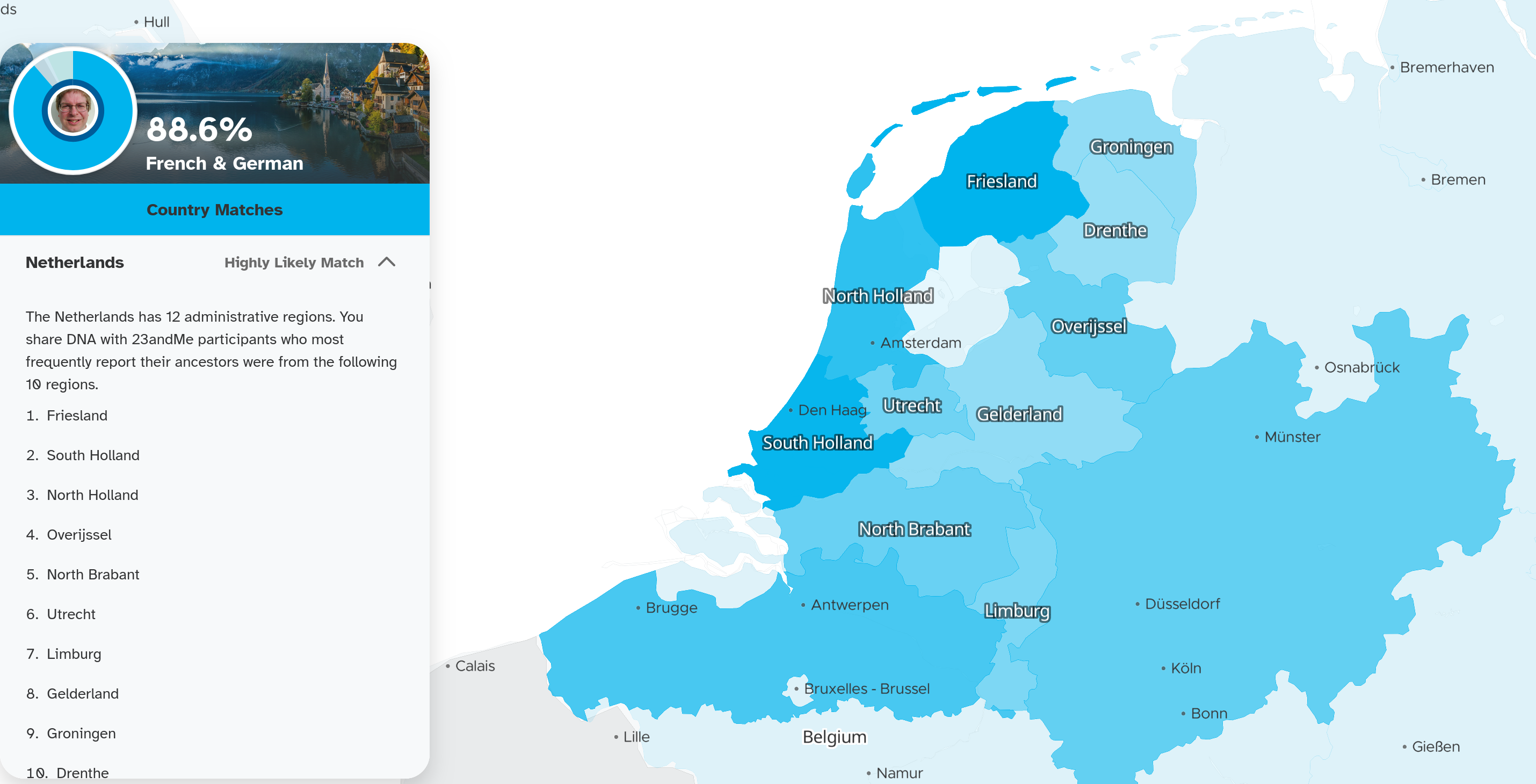 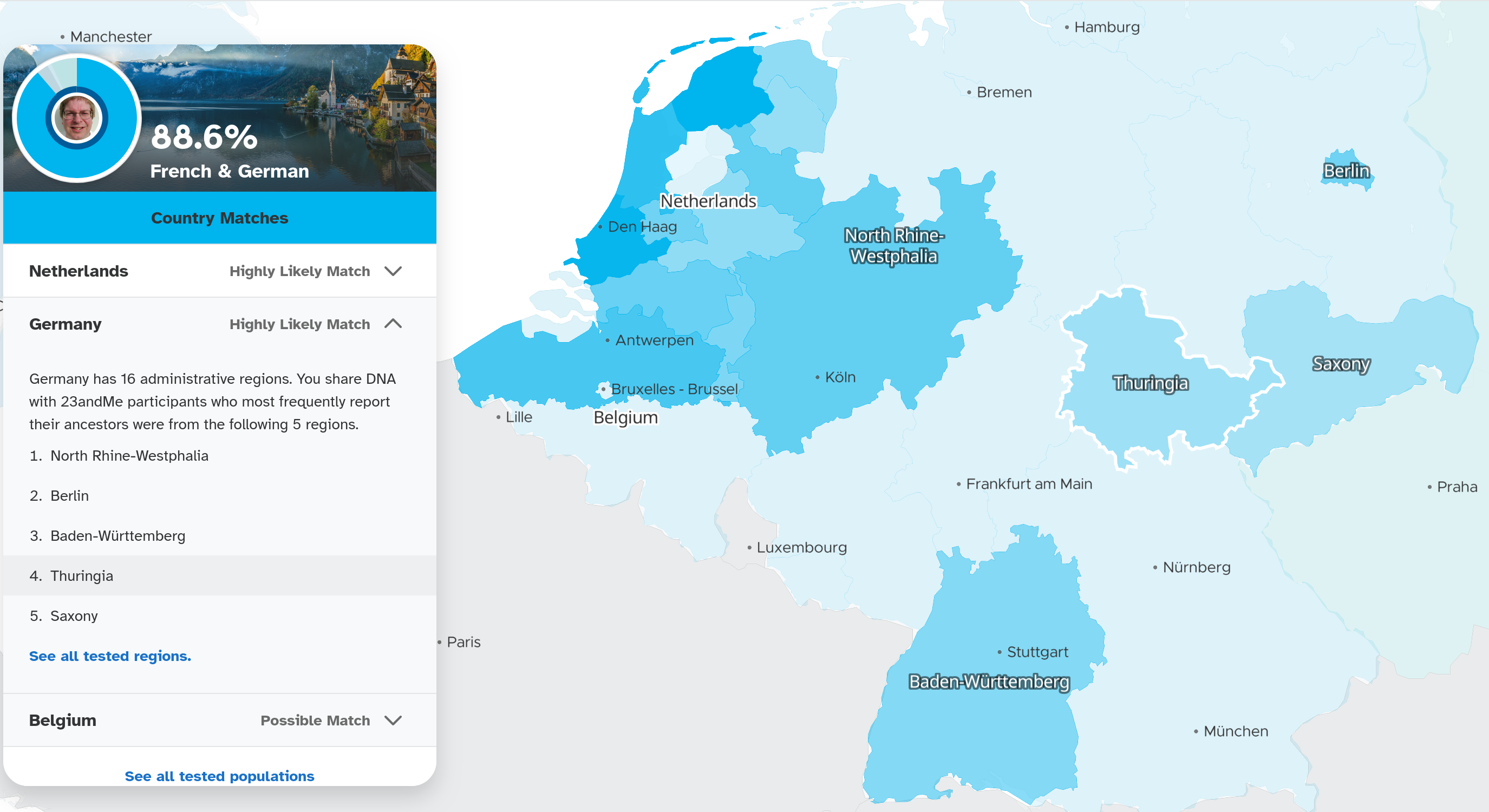 It is interesting that (West) Friesland (in the Netherlands) is highlighted, but not East Friesland (in Germany). Generically, 'Friesland' is probably as narrow as I can determine my Enns geographical origins around this time. |
  Using the DNA file generated by 23andMe, here is the analysis by MyHeritage DNA. They show a similar European ancestry (updated 2023): 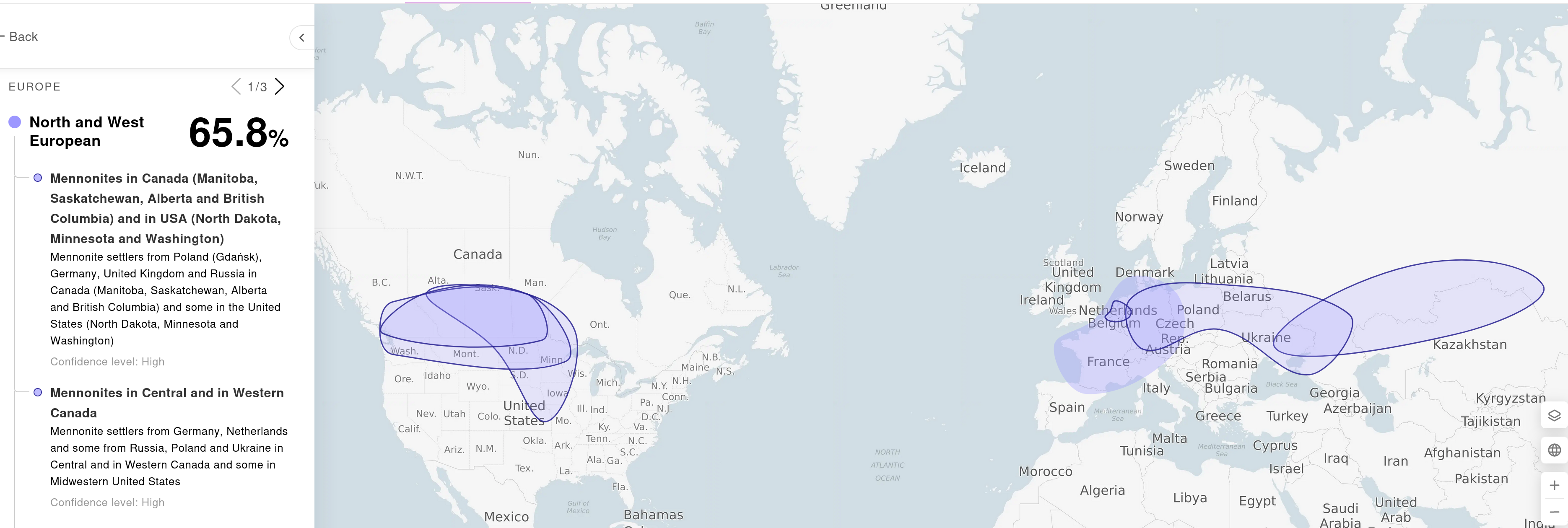 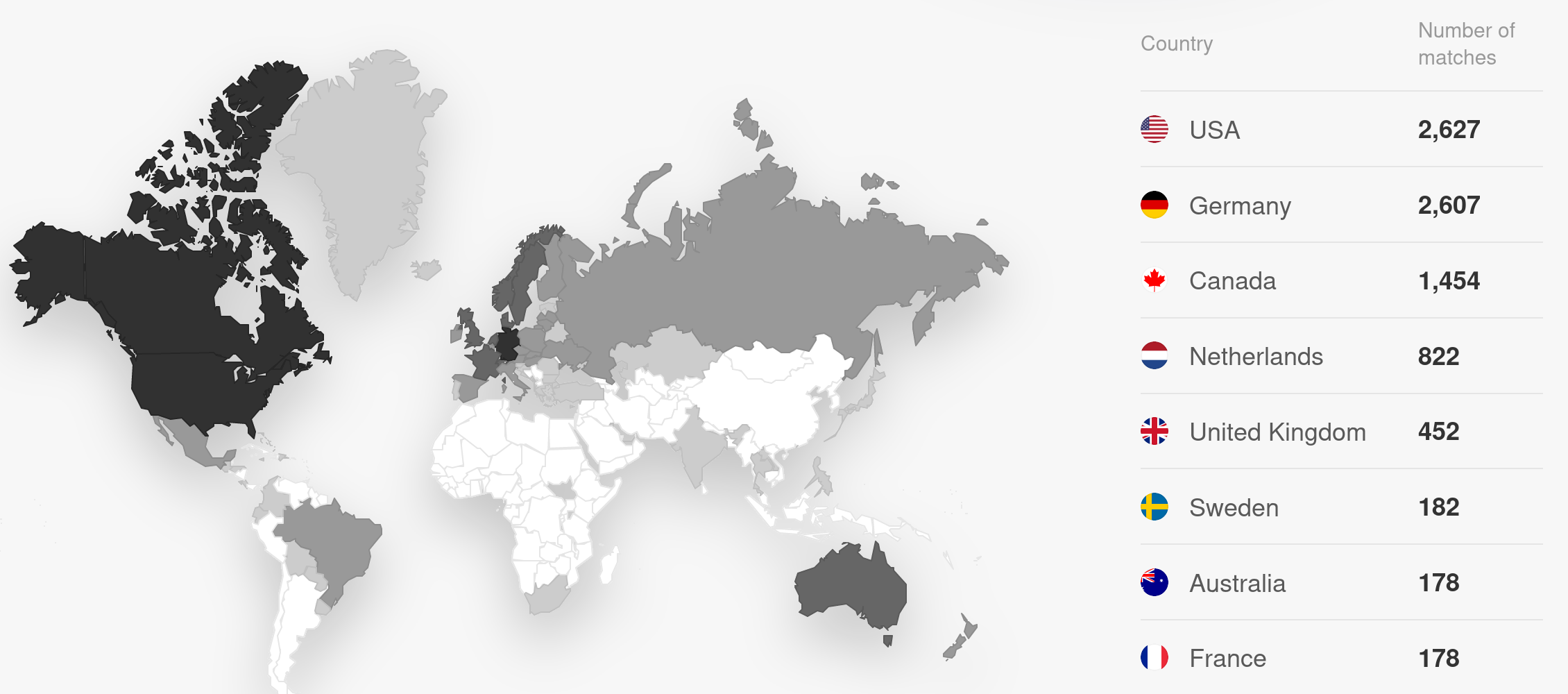 |
 Genomelink produced
this report analysis:
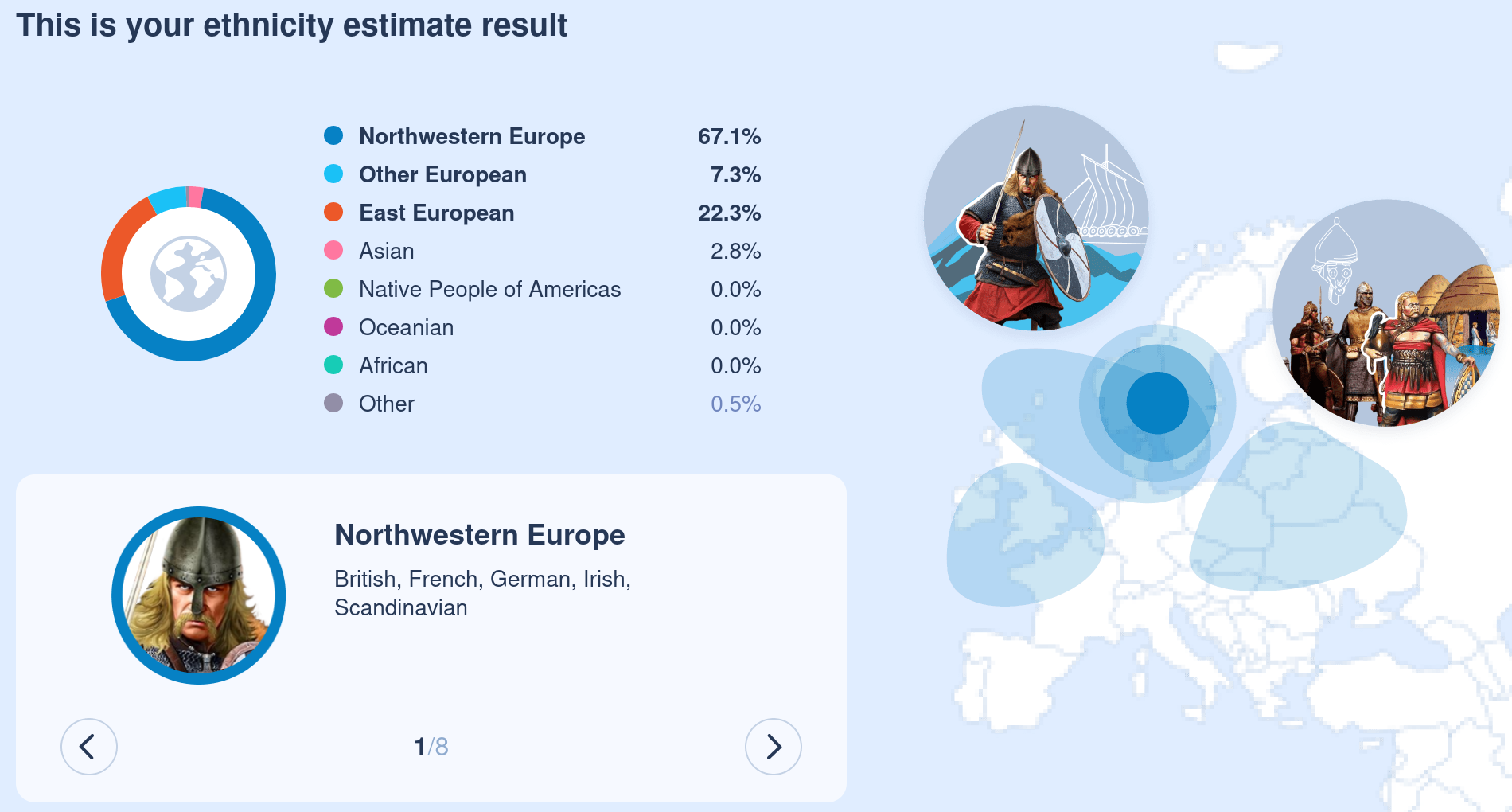 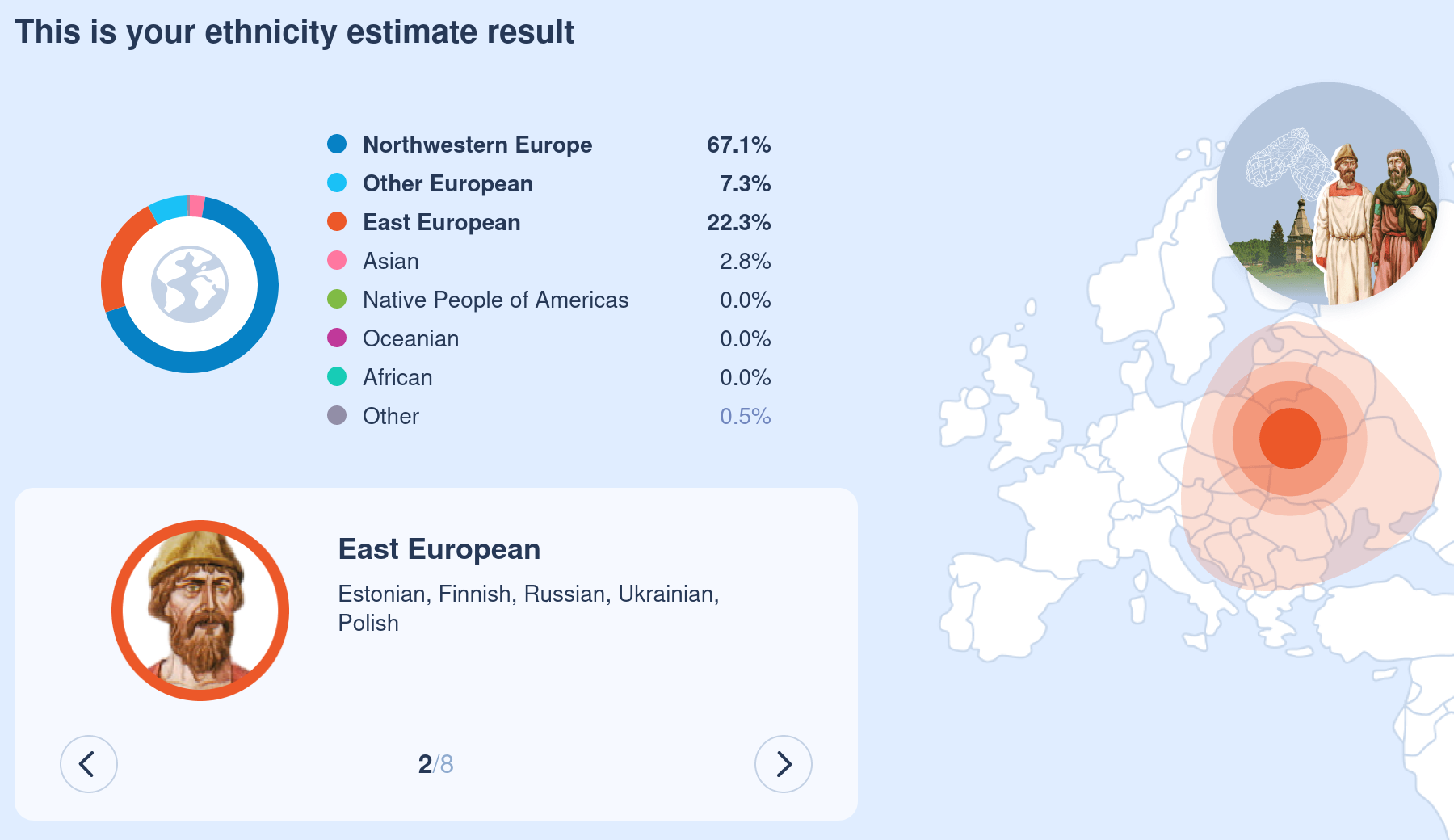 Also got my Ancient Admixture report from Genomelink. The largest portion of DNA heritage belongs to the 'Steppe Pastoralists' with the Yamnaya cultural background: 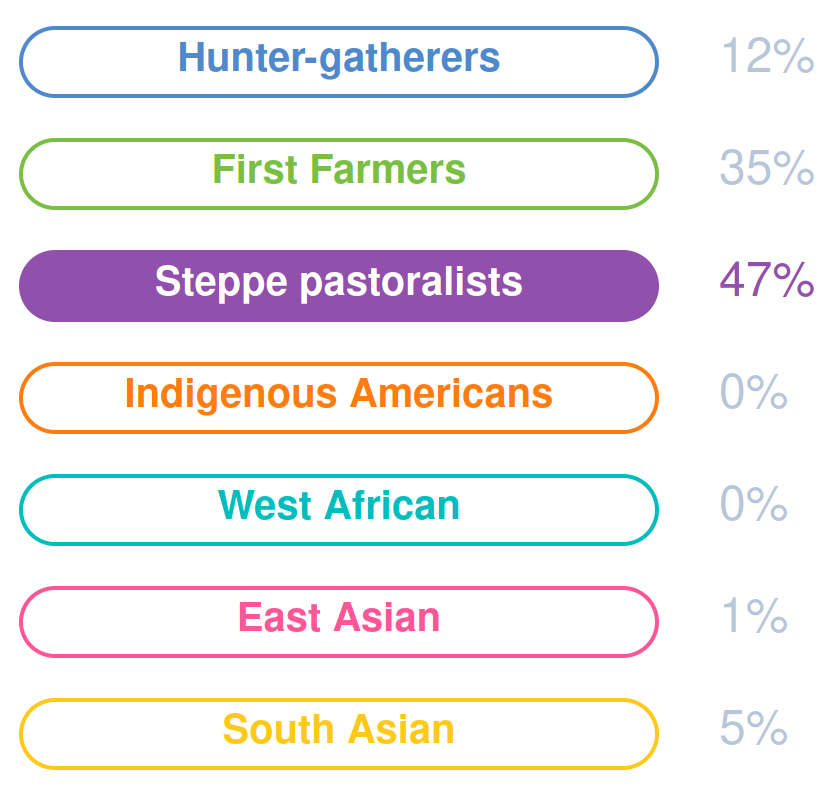 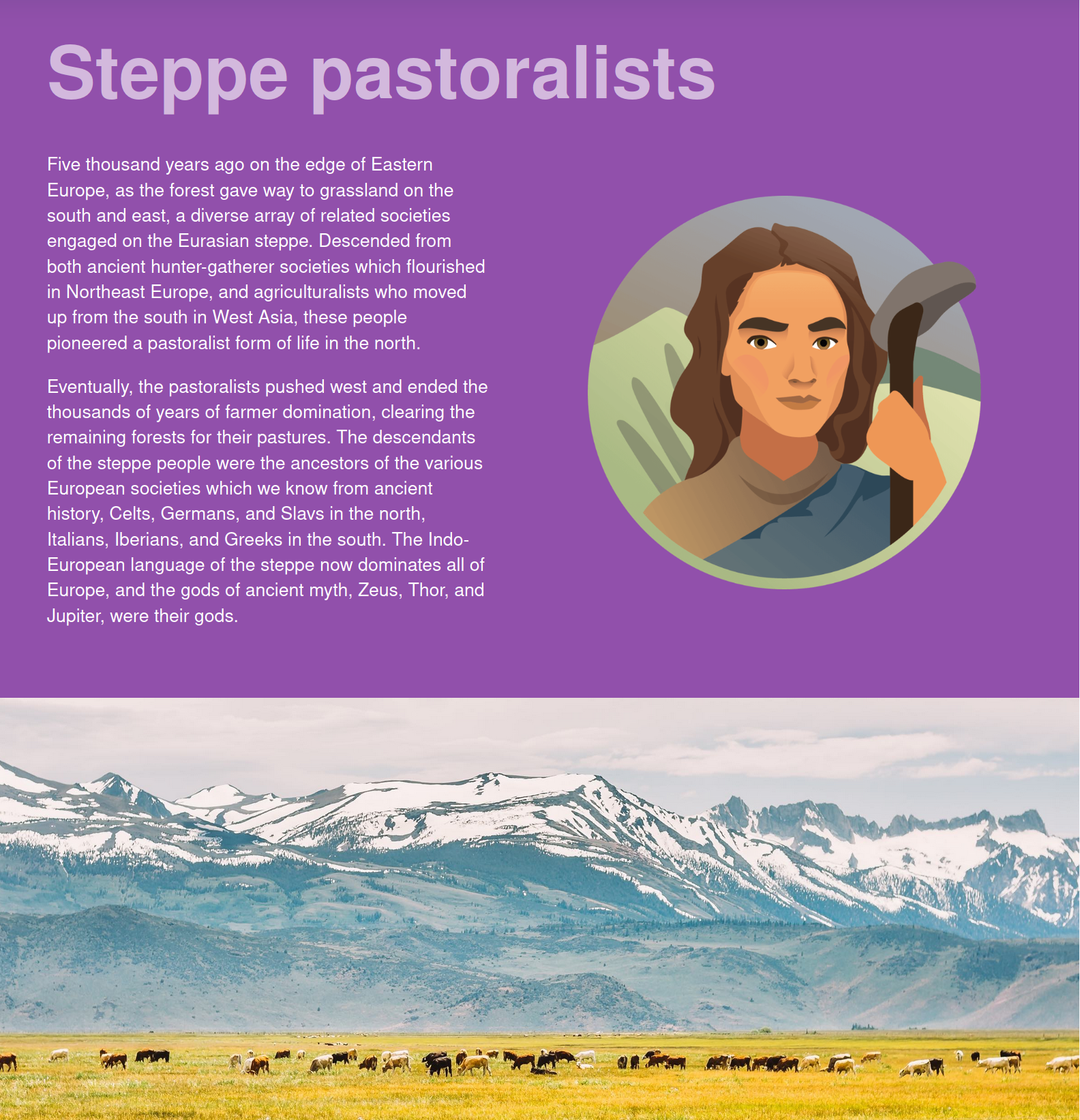 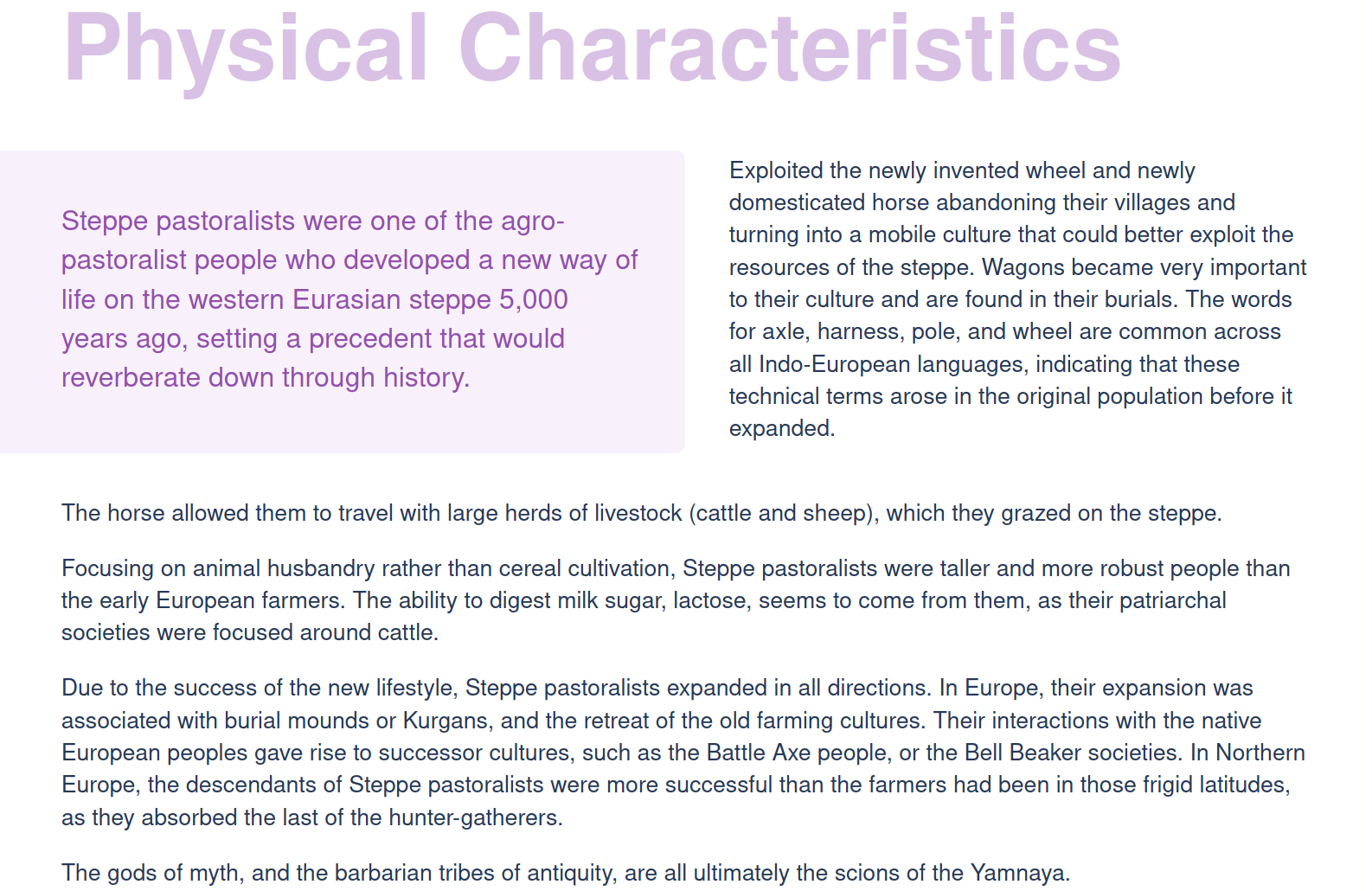  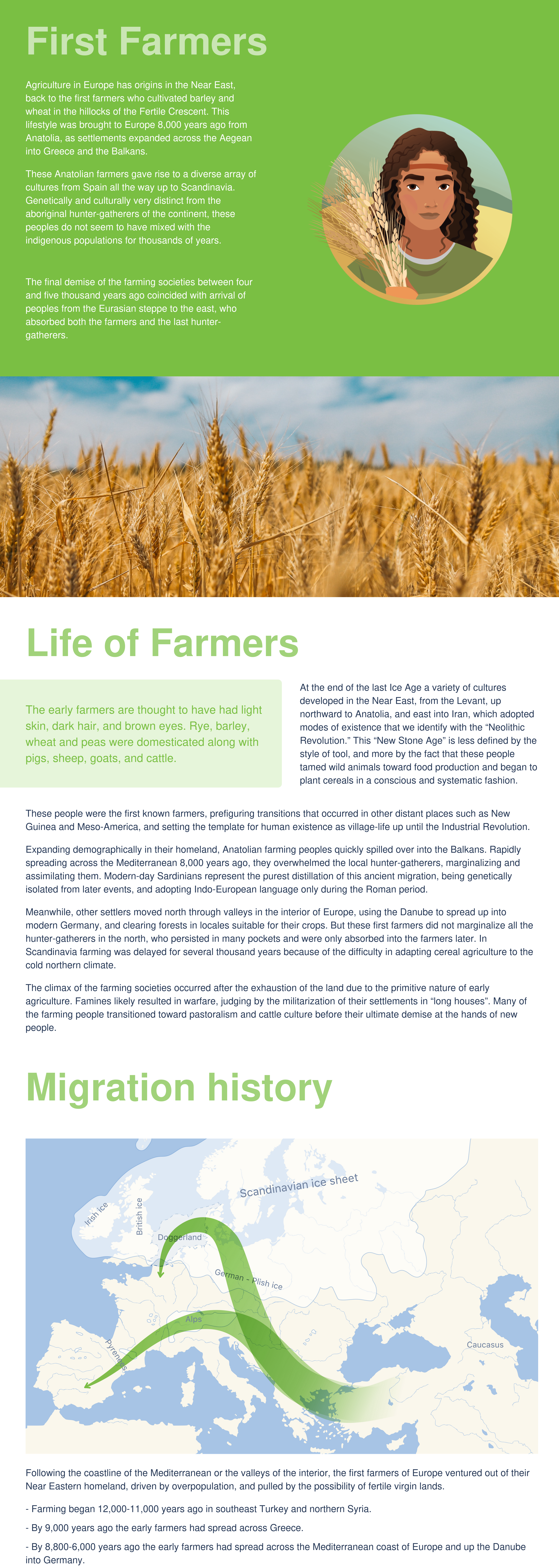 Genomelink also generated a 'Viking' report for me, which took my research into interesting directions! 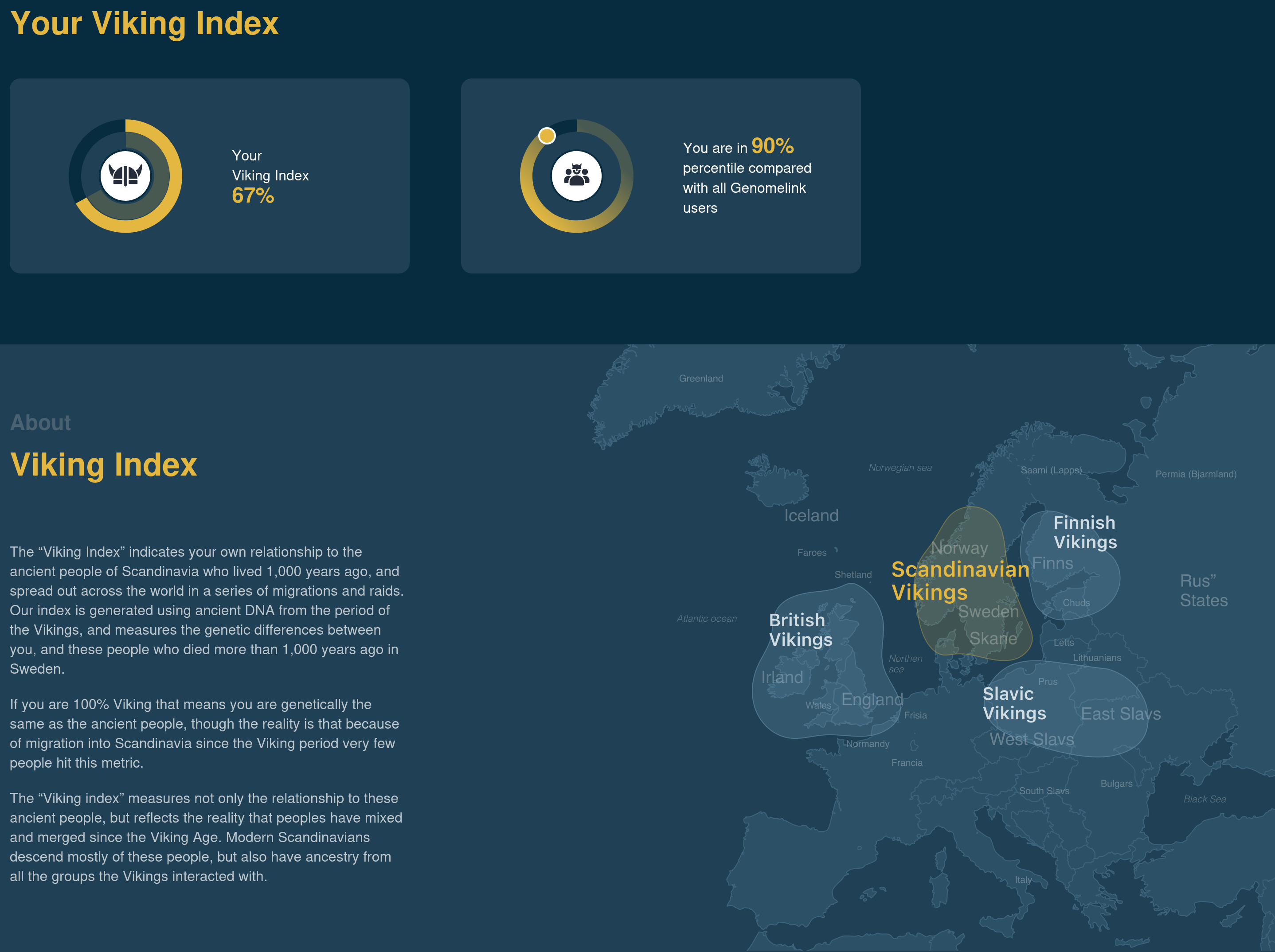  |
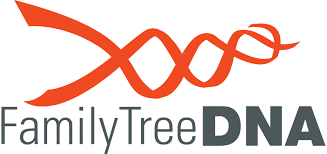 In order to specifically test my Y-chromosome for a direct-line paternal ancestry analysis, I submitted a new DNA sample to FamilyTree DNA. Rather than a map, they use a tabular form to show the European ancestry of my paternal line specifically:  Of particular interest is the purpose
of the Y-DNA37 test
itself -- at attempt to isolate my own paternal
ancestry from the many 'Enns' lines within my own
Mennonite background. This is the reason that I
joined the Mennonite
DNA Project (also Mennonite
DNA Project at FamilyTree
DNA). From what I can tell from my Y-DNA37 test,
in comparing with the other 'Enns' entries on their
project surname spreadsheet, only those I have marked
in green are those with
a possible true match to my own paternal
genealogical line (though 'Johann Enns (b. 22 Aug
1853) #171191' cannot be my ancestor, since he was
born after my actual ancestor 'Franz Enns (b. 23 May
1845)' -- though the two might be very closely
related):
From these (incomplete) results, we can already see that the known 'Ensz/Enns/Ens' surname can be divided into roughly 9 family lines -- basis Y-DNA37 tests. The 'Enz' entry is too different to all the rest to be considered part of our that line. Unfortunately, the Enns lines that have the closest match to my own Y-DNA37 test test have incomplete results. What is needed are more Enns males to test with FamilyTree DNA with a minimum of a 37 STR markers, and preferably more! Going forward, we will also want SNP tests to help establish the 'trunk' of our haplogroup line. Using FamilyTree DNA for both tests is a good option -- though another one I am exploring is to use a Whole Genome Sequence test by Dante Labs and use the "Y-Chromosome Sequence Interpretation" service of YFull to interpret the results -- potentially a better value (more results at a lower cost) but with the downside of not being able to data share with the Mennonite DNA results already hosted at FamilyTree DNA. Contact me for more information! Here is the 'Ensz/Enns/Ens' subset spreadsheet from the Mennonite DNA Project as above, but with my much-more-comprehensive STR marker results from YFull as extracted from my Dante Labs test inserted for comparison: |
What can be seen is that at levels of STR marker testing above Y-DNA37, that there is no longer an exact overlap with the genealogical DNA lines present. So, then, how unique is my particular family line? In addition to the Mennonite Project at FamilyTree DNA, there is another separate parallel site tracking similar DNA information for Low-German-speaking background Mennonites, at Mennonite DNA. Here are the comments by Tim Janzen in reference to the Enns lines present in this database: Enns. There are at least partial results back for 13 different unconnected Enns families. The haplotypes of the descendants of Dietrich Ens (1750-1825) #118136, Cornelius Enns (1788-1826) #50113, Jacob Enns (1796-1863) #456799, Abraham Enns (1787-1854) #265390, Isaak Enns (b. ca 1746) #196363, Isaak Enns (b. 1773) #265636, Johann Enns (b. 22 Aug 1853) #171191, Franz Enns (b. 19 Oct 1844) #185152, Gerhard Ens (ca 1755- 1806) #199341, Gerhard Gerhard Enns (1896-1957) #460911, Abraham Entz (1742- 1799) #7678, and Johann Klaas Enns (1741-1819) #44116 are consistent with each other, suggesting that they descend from the same Enns progenitor. The descendants of Dietrich Ens (1750-1825) #118136 and Cornelius Enns (1788-1826) #50113 who have been tested all have a value of 14 at DYS 389-1 whereas the other Ennses who have been tested have a value of 13 at DYS 389-1. This would suggest that Dietrich Ens (1750- 1825) #118136 and Cornelius Enns (1788-1826) #50113 were closely related to each other. The haplotype of the descendant of Johann Enz (b. 17 Jan 1828) #405788 who has been tested is inconsistent with the haplotype of the other 13 Enns males who have been tested. This is not entirely surprising because Johann Enz #405788 is known to have been born illegitimately and he took the surname of his mother Maria Enz (1789-1832) |
| DNA
HAPLOGROUPS Here is a bit more information on the
genetic haplogroups
that these tests reveal that I belong to.
Generically, my predicted paternal haplogroup by FamilyTree DNA is labeled R-M269 (in older references as 'R1b1a1a2'), and is primarily Western European. In other reports, my paternal haplogroup is labeled as R-U106 (older reference 'R1b1a1a2a1a1'), which is a subclade (subgroup) of R-M269. At the tip-most part of my paternal haplogroup, 23andMe tells me that I am part of haplogroup 'R-S16361' (older reference 'R1b1a1b1a1a1e1'). UPDATE: This haplogroup identification was confirmed by the yDNA data sample processed at DanteLabs and interpreted by YFull. Here is a link to a report of this haplogroup by ChatGPT DeepDive. This Eupedia link shows the path to this point:  Geographically, the best guesses for R1b-U106 (R-S21) are as follows: 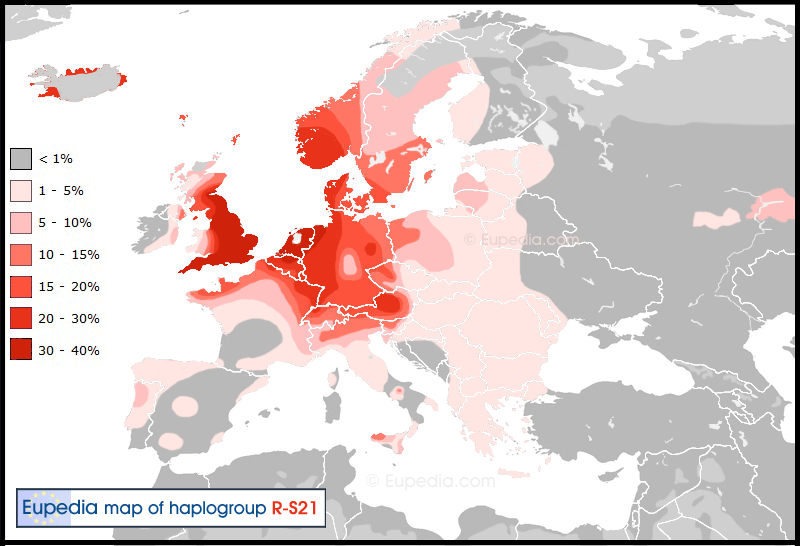 More information about R-U106 can be found here. A very detailed PDF report can be found here. The haplogroup chart for R-M269 on FamilyTree DNA shows the path to my S-16361 subclade shows the genetic tree structure in a different way, along with 'country of origin' hints (where Netherlands/Germany is especially applicable to me): 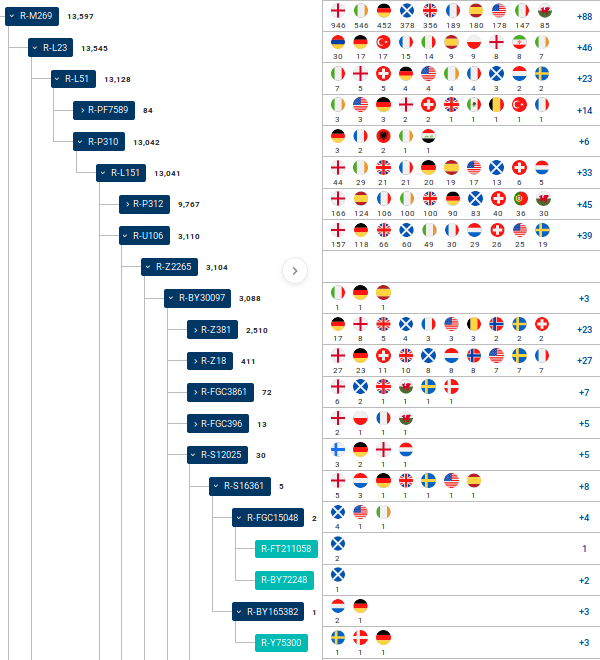 From what I can understand at this point, my genetics do not match to any of the deeper subclades of R-S16361, except for possibly R-BY165382. As an experiment, I Google-searched the web for information of anyone else with either R-S16361 or R-BY165382, and came across some entries in the spreadsheet for Frisian Waddenproject, so I extracted the three relevant rows, and combined them with my own as a point of comparison: When I asked the expert opinion of genealogist Tim Janzen on this matter, he indicated that 'the genetic distances would suggest that all 4 people in the spreadsheet likely share a common ancestor within the past 1000 years'. How cool is that? Since the concept of fixed surnames is a fairly recent practice, it makes sense that there are limits to how far back the 'Enns' paternal surname can go, and that my family origins might be linked to those with radically different surnames. A very useful U106 tree by Raymond Wing contains two rows for the R-S16361 subclade, which I have extracted here -- and it clearly references Frisian origins and a Gronigen location: As for my maternal haplogroup, 23andMe tells me that I am part of group H, which is the most common mtDNA clade in Europe. More information about H can be found here. UPDATE: With my newest report of my mtDNA data sample processed at DanteLabs and interpreted by YFull, I now know more accurately that this haplogroup is H10e! 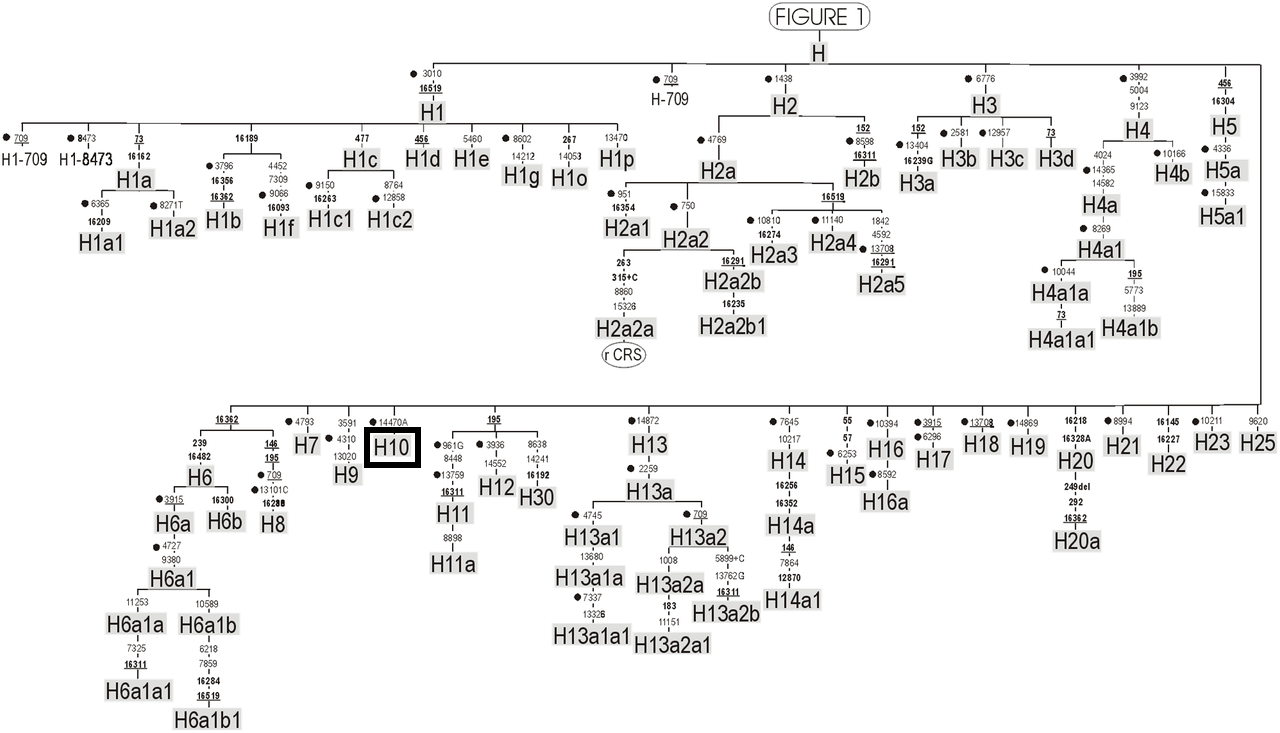 More charts and graphs from FamilyTreeDNA Discover on the R-S16361 haplogroup: 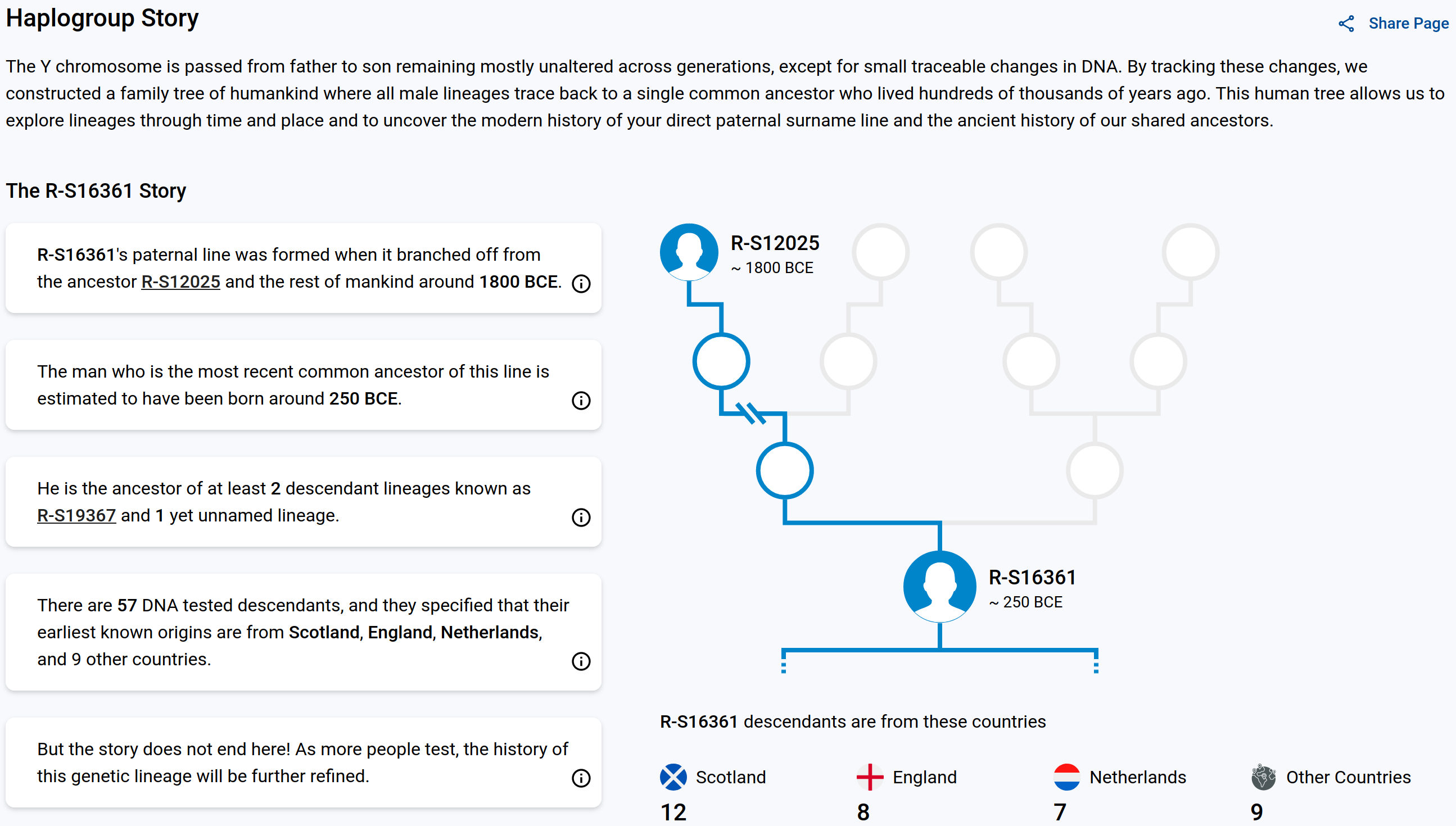 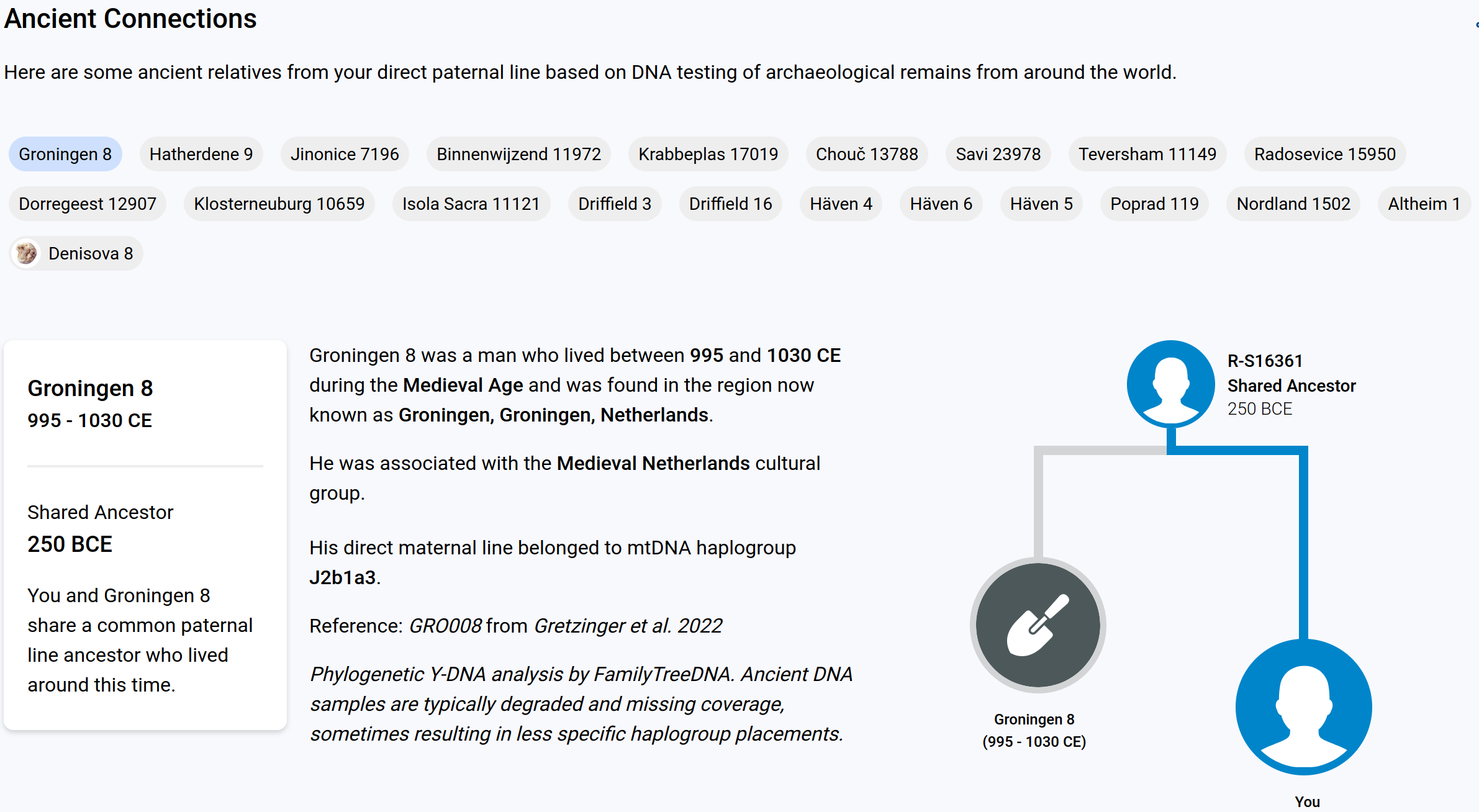 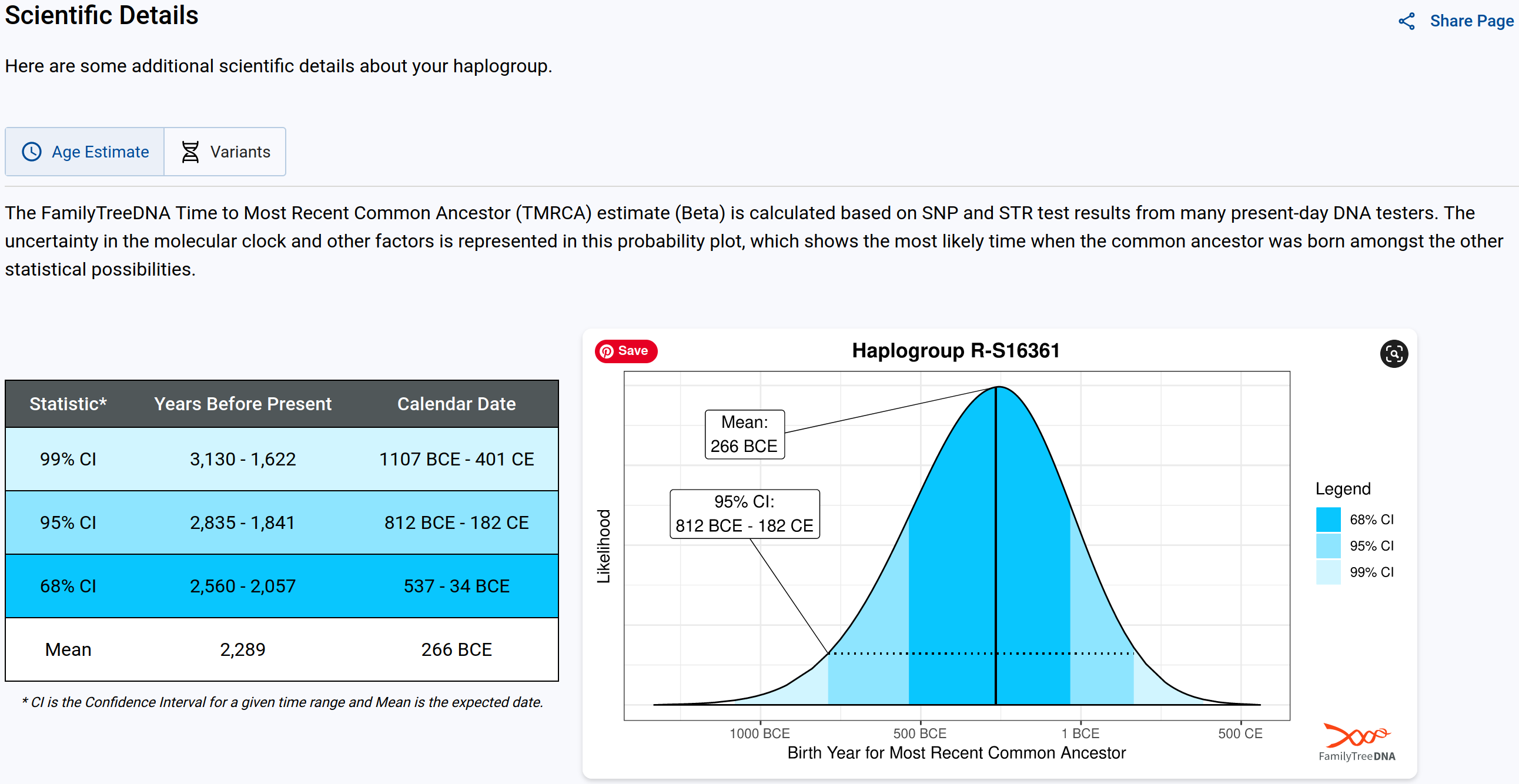 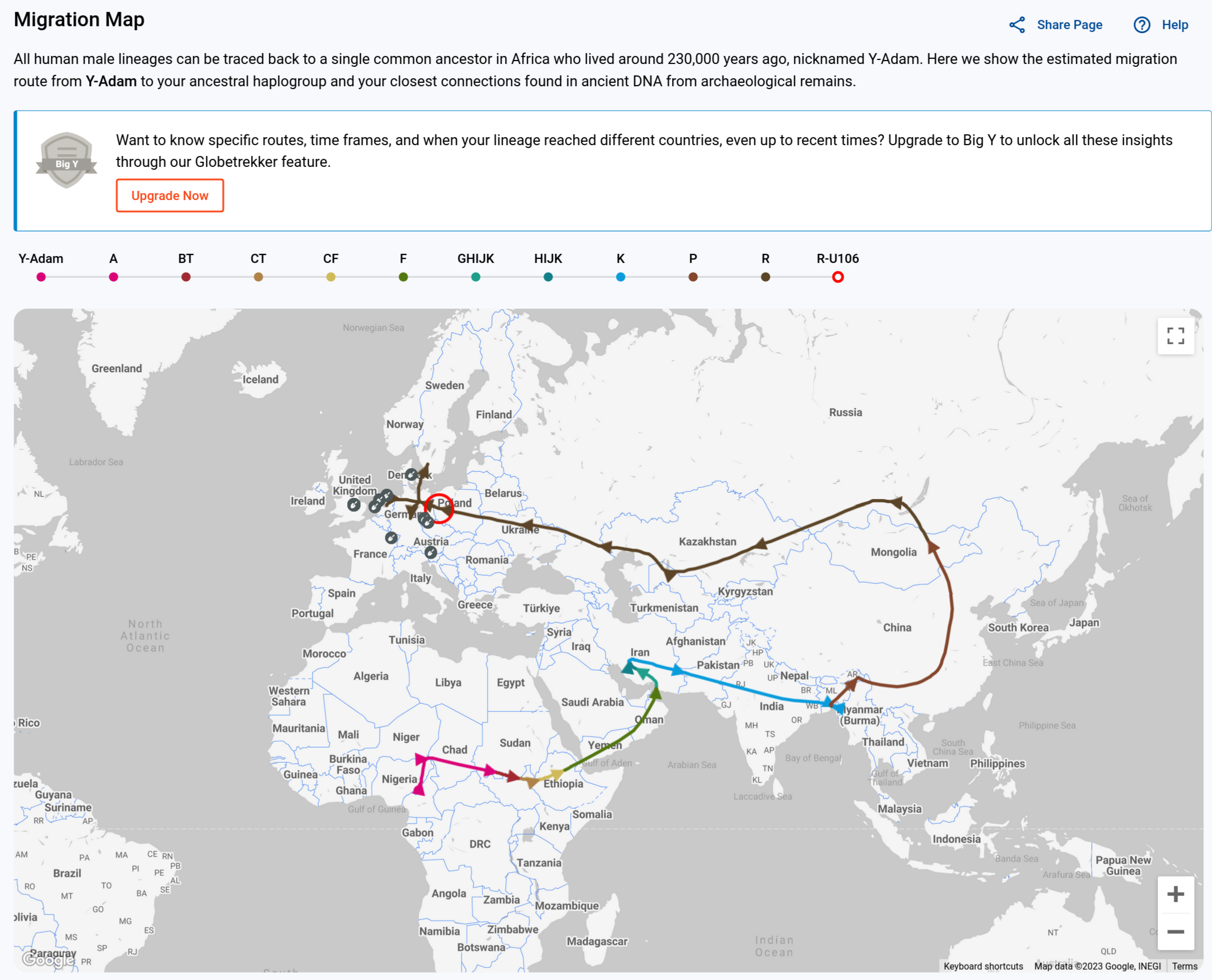 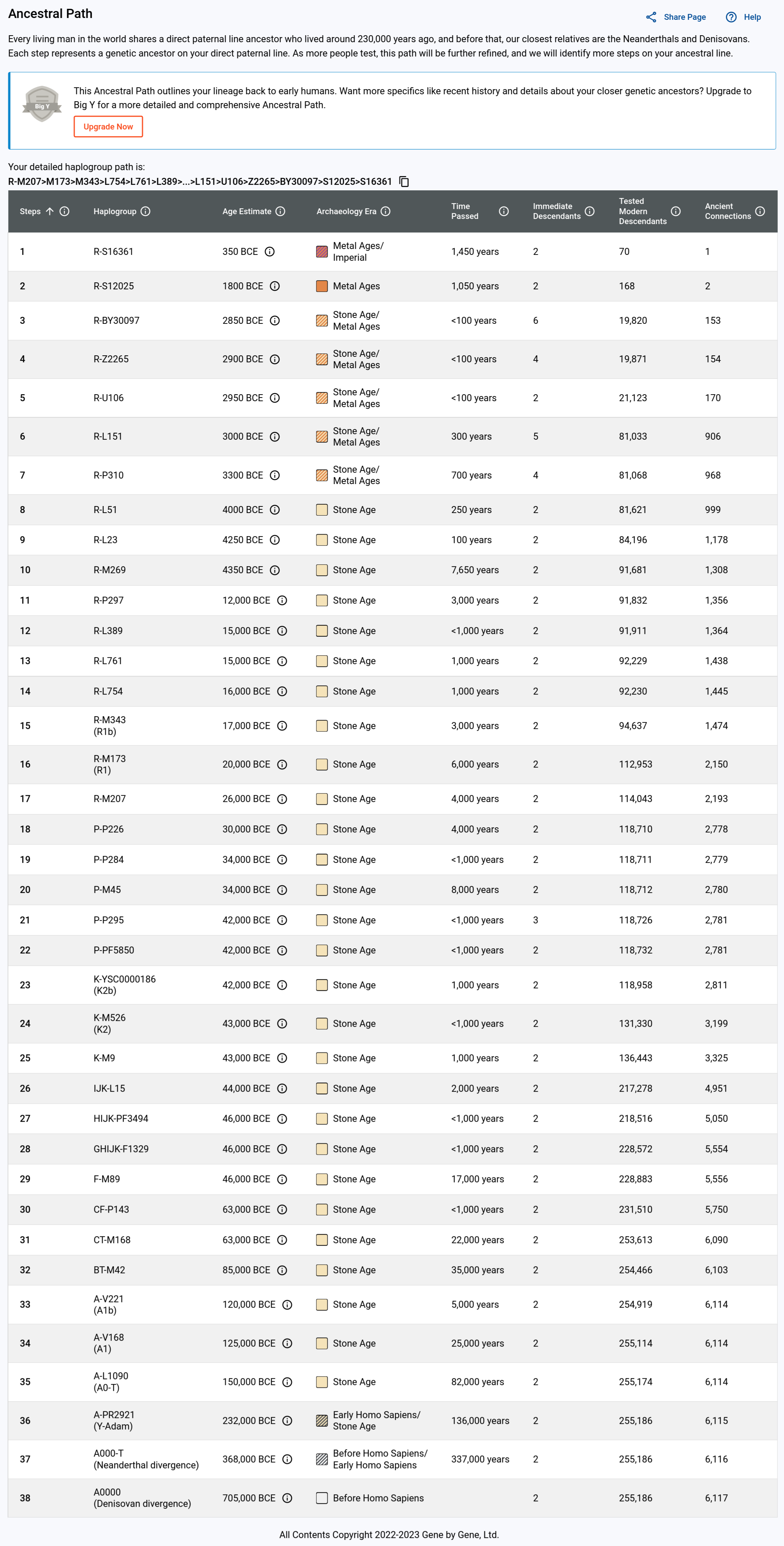 New reports from YFull on my S-16361 subclade:  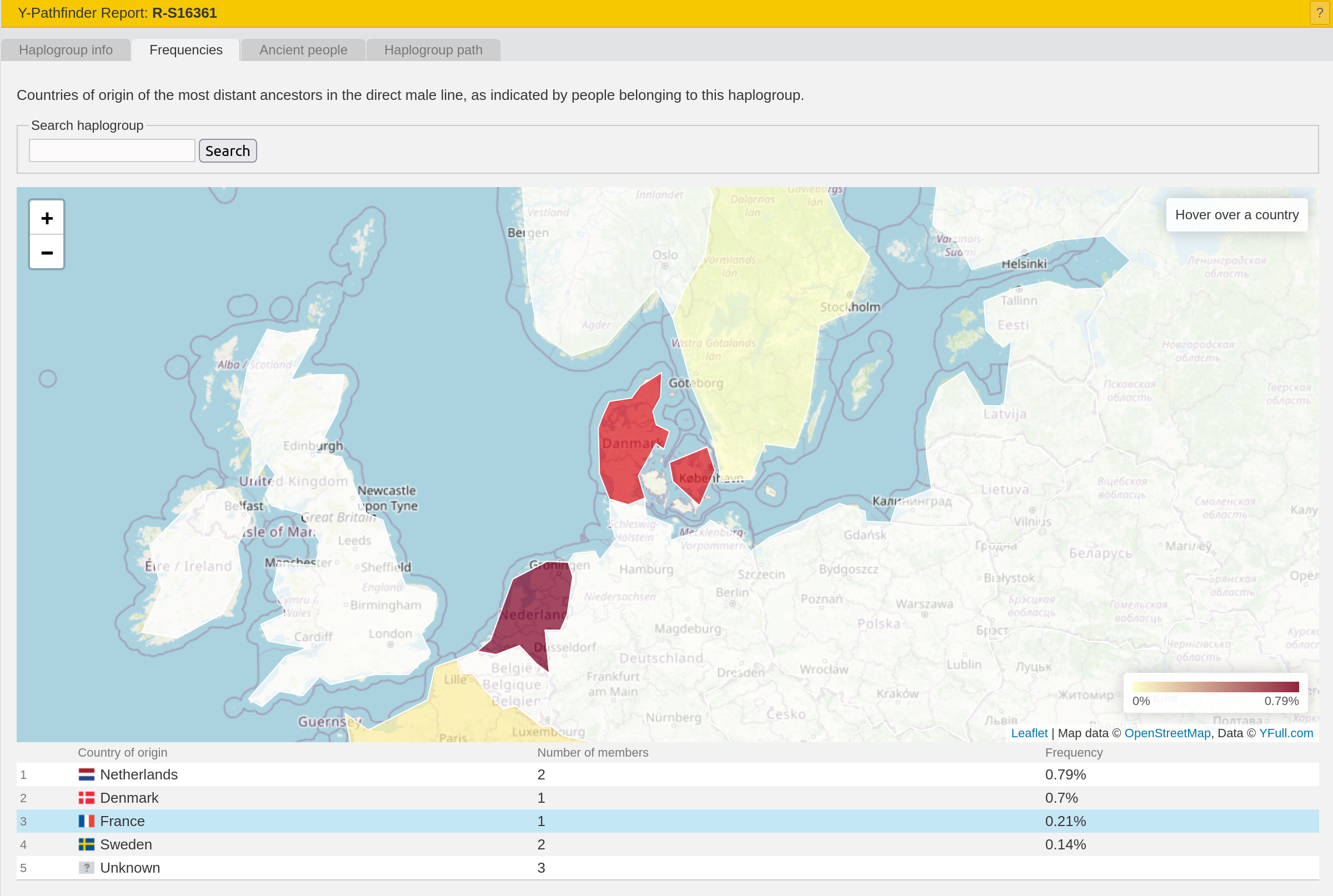   |
DANTE
LABS & YFULL DNA ANALYSIS
For those that may be interested in why/how I was able to process the massive DNA files produced for me by Dante Labs, in order to be able to send them to YFull for further processing, check this technical page. In the end, YFull was able to extract 654 reliable STRs out of the 780 produced by Dante Labs (84%!):  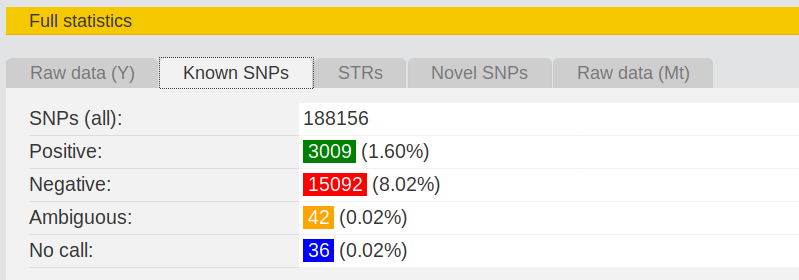  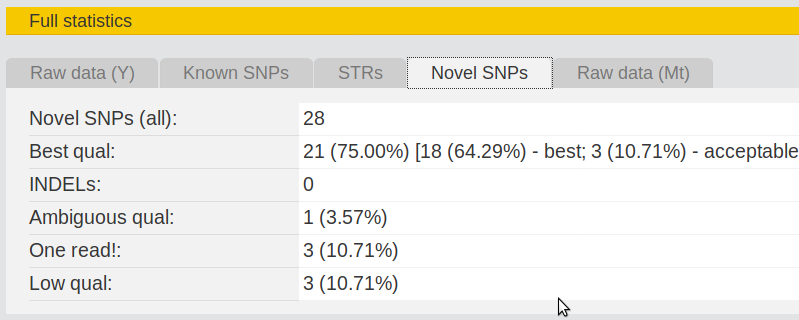  Here is a full report from YFull on my genome if you are interested :) |
| MENNONITE
DNA ANALYSIS An interesting study in the Journal of Human
Genetics titled Charting
the Y-chromosome ancetry of present-day Argentinean
Mennonites provides much useful information on
European Mennonite DNA origins:
"All Mennonite haplotypes were observed in Central Europe; with the Netherlands and Germany being the countries showing the largest proportion of haplotype matches (83% and 75%, respectively)" "This analysis indicates that the Netherlands is the population that best explains 75% of the Mennonite haplotypes, 58% of them with probabilities higher than 0.5 (a very high value when compared with those calculated for the remaining countries)." " In this MDS analysis, some structure in the European samples was revealed; for instance, Nordic populations appear clustered in one pole of the MDS; and Sweden is the country more closely related to Mennonite haplotypes (Skaraborg and Östergötland/Jönköping). A further elaboration on this MDS plot encompassed another analysis collapsing the 69 European samples in 23 groups representing the different European countries... This analysis showed again that the Netherlands, Denmark and Switzerland are the countries that are most closely related to our sample of Mennonite Y-chromosome haplotypes."  |
PRE-MENNONITE HISTORY Another area of research into my family
history project is the religious/cultural background
that my ancestors would have lived before the start of
their Mennonite identity and subsequent
migrations. A brief introduction is outlined in Early
Origins - Low German Mennonites:
The area from which the Low German Mennonites
originated is called “Dreier Friesland”. This is
located in the Groningen and West Friesland areas,
which then belonged to the Netherlands, and East
Friesland, located in northern Germany. It was in
these areas that a people who were known as the
“Friesians” lived, many of whom later converted to
the Mennonite faith.
In earlier times, the “Friesians” lived on the islands and coastal lands of the North Sea, before moving further inland. They were in constant battle with both the sea, which threatened to swallow their lands, and the Normans, their two greatest enemies. In the beginning of the eleventh century, the Friesians were conquered by the Normans. They had their land taken and many were sold as slaves. The Friesians were known as “Gottes Ehrenvolk” (God's honourable people) and the name itself is derived from a gothic word meaning “to be free”. Bartholomaeus Anglicus, a Franciscan Monk wrote that the Friesians were a strong, rough people, who were highly prideful of their freedom and unique ways. Roman documents describe them as courageous and loyal above all else. Friesian men declined being promoted to knighthood because they already saw themselves as knights. When Philip of Spain required the provinces of the Netherlands to pledge their oaths of allegiance, all bowed before him to swear fealty, save the Friesians, who declared “we kneel before God alone!” The Friesians were a pagan people until the eighth century. They stood their ground against the Christian influences of the Franks for many decades, before a minority submitted to the teachings of Wilfrid, the bishop of York. Christianity was tolerated among the Friesians and slowly grew between 690 and 739 A.D. Only after 754, when the English missionary Boniface died among them as a martyr, was Christianity widely accepted among the Friesians. And so, out of these fiery Friesians, nearby Flemish tribes and other Anabaptists who relocated in Friesland when the persecution began during the Reformation, arose a people, known today as the Mennonites. A much more thorough presentation is contained in the PDF file titled Frisian to Mennonite. Some other Wikipedia links to Frisian history and pre-Christian beliefs: |
 |
| The
above JPG image shows a map of the journey from the
Neu-Osterwick village of the Chortitiza
colony in the Ukraine to the homestead area near
Morden Manitoba Canada in 1876 (the nifty utility
that created this is called 'xplanet' found at http://xplanet.sourceforge.net/
using the following command: xplanet -projection
orthographic -config xplanet.conf -latitude 50
-longitude -30 -num_times 1 -geometry 800x800
-output migration1876.jpg -radius 50 -fontsize 10
-font Arial -pango) |
(the ship that brought Franz & Justina Ens (and family) to Canada in June 1876)Finally, after a 30+ year search for some sort of
photo or illustration of the SS Quebec, I
stumbled across a small image of the painting shown
above, painted in 1869 by John Frederick
Loos of the SS City of Dublin,
which was the ship name before it was sold to the Dominion Line
in 1873. Here
is a link to the original that I found, and here
is that image. Here
is where I got the one shown above (apparently
color-adjusted from the original). For another nice full-sized illustration of a ship very similar to the size/timeframe of the SS Quebec click this link. For a direct link to an HTML page that
contains the other passengers on the same voyage,
see this
link. For the actual page that shows their
entry on that voyage, see this
link. For a good general resource page
on Mennonite groups associated with my heritage, see
this
link to the MMHS website. See this
link for a search page of the 'Library and
Archives Canada' passenger lists 1865-1922.
NEW! While browsing Library
and Archives Canada, I stumbled across this
obscure reference to a ship named 'SS Quebec': L. STAFFORD, QUEBEC.
ARRIVAL SS "QUEBEC". I made inquiries,
and eventually acquired a digital image of this
correspondence confirming that this was the SS Quebec
arrival of my Enns ancestors, shown here:
This confirms how poor the arriving Mennonites were
-- so much so that L Stafford Colleet made an appeal
to waive some sort of 'transport' fee. Here is a
link
to an interesting 1879 Montreal Gazette article on the
history of the Montreal Telegraph Company. Another good site for ship info is Norway
Heritage. A very good source of
technical information for the Lloyd's Register of
British and Foreign Shipping is Mystic
Seaport. The Immigrants
to
Canada is also good for info. The ship that brought the Enns family
over to Canada from Russia was the "SS
Quebec". General information on the ship and
the line(s) to which it belonged are described
below. The ship departed from Liverpool on June
8/1876 and docked in Quebec on June 23/1876 (15
days). It was the 22nd ship arriving in Quebec in
1876, and the 18th ship containing Mennonite
immigrants. The captain of the SS Quebec during this
time was Captain
J. Thearle (not W. Bennett as previously
guessed, though he was Captain on earlier and later
voyages). The leaders of the group were David
Giesbrecht and Franz Froese. The origin of the group
was the Fuerstenland
colony in south Russia (a daughter colony of
Chortitza settlement). There were 225 Mennonites on board,
including the 8 members of the Franz & Justina
Enns family. One of their children (Justina)
apparently died during the voyage. Some sort of processing fee was paid in
Toronto on June 26/1876 ($16.98). By coincidence, the Peter & Elizabeth
Hoeppner family was also on this ship -- Peter being
a grandson of the first
delegate chosen in Danzig to act as a negotiator
with the Russian government with regards to the
migration of Mennonites to Russia in 1788! NEW!
Through the magic of Google searches and
scanned documents, more information re: Captain J.
Thearle came to light: Full name John
Thomas Thearle, born in 1831, from Plymouth,
the son of a mariner, became a mariner himself in
1846 (age 15), became a
ships' mate in 1852 (age 21) aboard the steamship
"Olinda" under Captain George Hugh Haram, was 2nd
mate in 1854 when the "Olinda"
was involved in a wreck
during its 2nd voyage, presented testimony
at an investigation that same year, married
in 1858 (age 27), and eventually became
captain of the "SS Quebec" for the voyage of my Enns
ancestors in 1876 (age 45). A small mystery is what colony Franz
and Justina lived in before emigrating to Canada
-- Fuerstenland (from which others on their journey
originated) or Neu-Osterwick (which various
other records suggest)? Yet another record
indicates that Franz was born in the Bergthal
colony. Since the journey took 15 days, and
the distance between Liverpool and Quebec City by
ship is 2649 miles, this means that the average
speed was 7.4 mi/hr or 11.8 km/hr or 6.4
knots. This is another mystery, considering
that the average steamship speed for this route at
the time was 9.5 days (11.7 mi/hr or 18.8 km/hr or
10.2 knots)! Other accounts suggest that the
average route time was 12 days -- in which case this
journey was slightly slower. Now for the general historical information about this ship and its line...
The QUEBEC was built by Smith
&
Rodger, Glasgow. She was a 2,138 gross ton ship,
length 318ft x beam 36.3ft, clipper stem, one funnel,
three masts (rigged for sail), iron construction,
single screw and a speed of 11 knots. Laid down for
British owners as the HELLESPONT, she was bought on
the stocks by the Inman
Line of Liverpool and launched in February 1864
as the CITY
OF DUBLIN. She started her maiden voyage on
10/12/1864 when she left Liverpool for Queenstown
(Cobh) and New York. Her last voyage on this service
commenced 2/4/1872 and she was then purchased by the Dominion
Line of Liverpool, and fitted with compound
engines by Laird Bros, Birkenhead. She started a
single round voyage between Liverpool and Boston on
19/2/1874 and was then renamed QUEBEC. She commenced
Liverpool - Quebec - Montreal voyages on 16/4/1874 and
started Avonmouth - Quebec - Montreal sailings on
30/4/1886. Her last voyage between Avonmouth, Swansea
and New York started on 16/12/1887 and in 1888 she was
sold to French owners and renamed NAUTIQUE. On
16/2/1890 she was abandoned and lost in the North
Atlantic. [North Atlantic Seaway by N.R.P.Bonsor,
vol.1,p.241] [Immigrant
Ships
and ShipsList] Laid down in the Glasgow yards of Smith
& Rodger as the Hellespont, her iron
hull was purchased on the stocks by the Inman
Line who renamed her City
of Dublin prior to her launching in
February 1864. Completed later the same year, she was
registered at 2,138 tons gross and measured 318 feet
in length with a 36 foot beam. Driven by a single
screw powered by a beam-geared 2-cylinder engine, she
could cruise at 11 knots and carried accommodation for
100 Cabin and 400 Third Class passengers. After eight
years of scheduled Liverpool to New York sailings, she
was sold to the Dominion Line in 1873, fitted with new
compound engines and put to work on their Liverpool to
Boston run. After only one return voyage, she was
renamed Quebec and transferred to their
Liverpool, Quebec and Montreal route where she
remained, apart from a change of home port to
Avonmouth, until December 1887. Sold to French owners
in 1888 and renamed Nautique, she foundered
after being abandoned in a sinking condition in the
North Atlantic on 16 [1864] City of Dublin Bt Smith & Rogers, Glasgow; T: 2,138 g. Dim 318 ft (96.93m) x 36 ft 3 in (11.05 m) x 29 ft 5 in (8.97 m). Eng Sgl scr, beam geared; 2 cyls, 11 kts. H Iron, 2 decks; Pas: 100 cabin, 400 3rd. [Merchant Fleets in Profile] [1864] (Similar entry to above) Laid
down as Hellespont for W. Dixon, British.
Acquired on the stocks. Sept 3: Renamed City of
Dublin, Inman Line. Liverpool-Quebec-Montreal.
Replacement for Missouri (8), lost Oct 1. [Merchant
Fleets
in
Profile] [1864] The Inman Line fleet was
reinforced by a sister ship to the City of New York,
the City of London, (1863, 2,560 tons). The major
difference between the two vessels was in their
machinery. The City of New York had two-cylinder
horizontal trunk engines, whereas the the City of
London had four-cylinder inverted engines. Besides
the fact that war freight to the United States more
than justified fleet expansion, disasters always
loomed over the horizon. The City of New York was
steaming fast toward Queenstown on a homeward
crossing from New York when she struck the submerged
seamount known as Daunt's Rock and became a total
loss. The accident occurred early on the morning of
29 March 1864, and the potential for human tragedy
was great, but all passengers and crew were saved.
Inman surveyed the ship market as quickly as
possible for a replacement and Smith & Rodger,
Glasgow, Scotland, had a 2138 ton vessel building
which appeared to meet the bill. She bore the name
Hellespont, but was purchased by Inman and launched
as the City of Dublin in February 1864. As prepared
for Inman service the liner was outfitted with
around 100 cabin class berths and accommodation for
nearly a thousand steerage passengers. She made her
maiden voyage from Liverpool to New York on 10
December 1864, the fitting out taking a little
longer than [1864] Dec 17: The ship "Burnside"
of Greenock, while on a voyage from New York to
Liverpool, became waterlogged, and was struck by a
heavy sea which caused her to heel over, and eight
of her crew were washed overboard. She
afterwards righted, but two more were washed away,
and two died from exposure. The remaining three,
after enduring the greatest sufferings from cold and
exposure for six days, were rescued by the "City of
Dublin," about 900 miles west of Cape Clear. On
account of the heavy sea running, and the danger of
approaching the wreck, the rescue of the survivors
was attended with great difficulty and danger to Mr.
Fletcher and the boat's crew. [Parliamentary
Papers, House of Commons and Command, Volume 65,
p 66][New
York Times, Dec 29, 1864] [1873] Became Quebec (Dominion Line). Compound engines fitted; Cyls: 46 in (116.84 cm) and 78 in (198.12 cm); Stroke: 42 in (106.68 cm); 275 HP; Stm P: 60 lb; by Laird Bros, Birkenhead. [Merchant Fleets in Profile] [1874] Montreal Witness of May 5,
1874: Serious loss and delay have been experienced
by steamers owing to the continued obstruction of
the river by the ice-bridge at Quebec. The
"Sarmatian" has been kept waiting below at Indian
Cove for nearly a week in consequence, and owing to
the difficulty of landing has had to keep her
steerage passengers on board all the time. The SS.
"Quebec" of the of the Dominion line contrived to
have her passengers landed, and it is stated those
from the "Sarmatian" will also be landed to-day.
Other vessels are also detained below and the number
is being fast augmented. Efforts are being made to
break up the ice obstruction, which, it is hoped,
will be effected to-day. Fears are expressed that
the ice at Cap Rouge will hold for some time longer,
but from Three Rivers it is reported that the Lake
ice had been passing down rapidly, and it is to be
hoped that at Cap Rouge will also give way speedily.
[TheShipsList] [1875] Nov 5, The Central Law Journal,
Volume 2, page 725: Collision of Vessels -- The S.S.
Quebec, Bennett; Vice-Admiralty Court. Opinion
of Y. Okill Stuart, J. [19 Low, Can. J. 195]. A
steamship, after colliding with a sailing vessel,
continued her course and struck another sailing
ship. Held, that the steamship that had
disregarded the rules of navigation before the first
collision, could not plead the fault of the vessel
first struck, to a suit brought against her for the
second collision...Collision between Steam and Sail
Vessels. -- The S.S. Quebec v. The Charles Chalomer;
and vice versa; same court and judge. [19 Low. Can.
J. 201]. Held, where a steamboat did not keep
out of the way of a sailing ship, there being risk
of collision, and the sailing ship, by porting her
helm, instead of keeping her course, contributed to
the collision, both held to be in fault and neither
entitled to recover the damage she sustained. [The
Central Law Journal] [1875] Oct 15, Where one steamship overtook another in a shallow channel, in the river St. Lawrence, and a collision ensued, the overtaking vessel declared to be in fault. The Quebec -- Thearle, p 37. [Cases selected from those Heard and Determined in the Vice-Admiralty Court at Quebec Involving Questions of Maritime Law][detail] [1876] May 11 The SS "Quebec" from
Liverpool to Quebec reported having seen a few
icebergs. Had fine clear weather until 20 miles
above the Bird Rocks then the ship got into field
ice and steamed 120 miles through it. On the 9th 15
miles off Cape Rozier, the ship passed two Norwegian
barques below the Bird Rocks and saw 11 sails in the
ice. (LL). [Ice
Charts
&
Ship/Iceberg
Database] This ad comes from a
very interesting traveler's book from 1876 called The
Year Book and Almanac of Canada for 1876,
confirming the Captain on that voyage as 'Thearle':
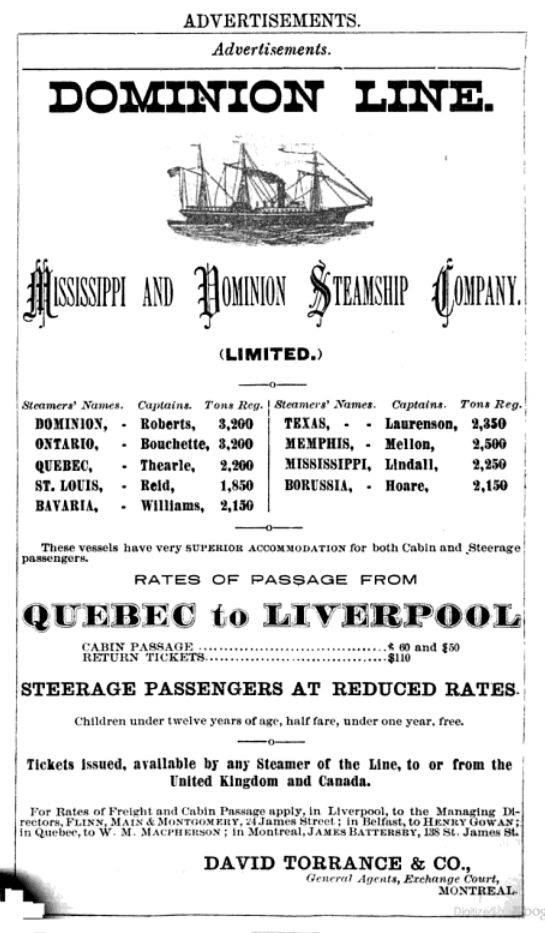 Here is what the entry in the Lloyd's Register of British and Foreign Shipping for 1877/1877 for the 'Quebec' looks like:  [1879] In
September, 1879, the SS Quebec, a Dominion Line
steamer on a voyage from Halifax to Montreal with
60 passengers, had struck within a few yards of
where the Phoenix met her fate. After the crew
jettisoned her cargo of sugar, salt, and iron, she
slipped off the reef and continued on her voyage.
Evidence before a Court of Inquiry of the Board of
Trade into that incident showed conclusively "that
the accident occurred through miscalculation of
the distance of the light from the reef, the
master supposing it to be upon the hill of the
Point." "On the hill of the Point" was where East
Point Lighthouse was marked on Admiralty Charts.
In fact, the tower, which had been built in 1867,
stood half a mile south of southwest of the Point.
The Chart location was in error. [The
Wreck of the Phoenix] [Daily
Telegraph Newspaper article 1879/09/04] [1882] Apr 25 SS "Quebec" met heavy ice 46o31'N 47oW from which she did not clear until May 1; Apr 29, 47o32'N 59o35'W; Gulf completely blocked. [Ice Charts & Ship/Iceberg Database] [1883] Feb 19 Safe Arrival off the Port. The anxiety which has been felt respecting the delay of the arrival at the home port of the Quebec, of the Dominion line, will be set at rest by knowledge of the fact that she was off Holyhead at a quarter-past eight this morning, accompanied by, but not in tow of, the tug Gamecock, of Liverpool. Beyond delay, all is well, and the vessel is expected to come into the river Mersey this evening. [The Liverpool, Monday February 19, 1883] [1883] Mar 9 The Voyage of the S.S. Quebec. Presentation to the Officers and Crew. A crowded meeting of Shipowners, Merchants, Shipmasters, and others was held at the Rooms of the Mercantile Marine Service Assocation, on the 9th March, when a sum of 1,000 guineas, given by the Liverpool Underwriters, was distributed amongst the Officers and crew of the steamer "Quebec", of the Mississippi and Dominion Line, in recognition of the skill and devotion displayed in navigating that vessel safely to Liverpool, after her rudder had been carried away in the Atlantic...others present were Messrs. Montgomery, Flinn & Hill, of the Mississippi and Dominion Steamship company, owners of the "Quebec"...and Captain Gibson and the Officers and crew of the "Quebec". [H 387.06 MER Mercantile Marine Service Assocation Reporter Vol VIII 1883] [1883-1888] On Avonmouth berth. [Merchant Fleets in Profile] [1883]
(Similar to entry above) Sold. Renamed Nautique.
Owned by Bossiere Freres & Cie, France. [Merchant
Fleets in Profile][1888] QUEBEC, ex.
HELLESPONT, ex. CITY OF DUBLIN Code letters: VWHQ
Official Number: 48807 Rigging: iron single screw
steam Bark; 3 decks; partial Shade Deck; 6
cemented bulkheads Tonnage: 2,621 tons gross,
1,991 under deck and 1,732 net Dimensions: 318
feet long, 36.3 foot beam and holds 29.5 feet
deep; Poop 80 tons; Forecastle 24 tons
Construction: 1864, Smith & Rodger in Glagow
Propulsion: compound engine with 2 inverted
cylinders of 46 & 78 inches diameter
respectively; stroke 42 inches; operating at 55
p.s.i.; 300 horsepower; new engine & boilers
in 1873; engine built by Laird Bros. in Birkenhead
Owners: Mississippi & Dominion Steam Ship Co.
Ltd. Port of registry: Liverpool [Gilbert
Provost - from his research using Lloyd's
Register -- much thanks!] [1890] Feb
10: Foundered in North Atlantic. [Merchant Fleets
in Profile] 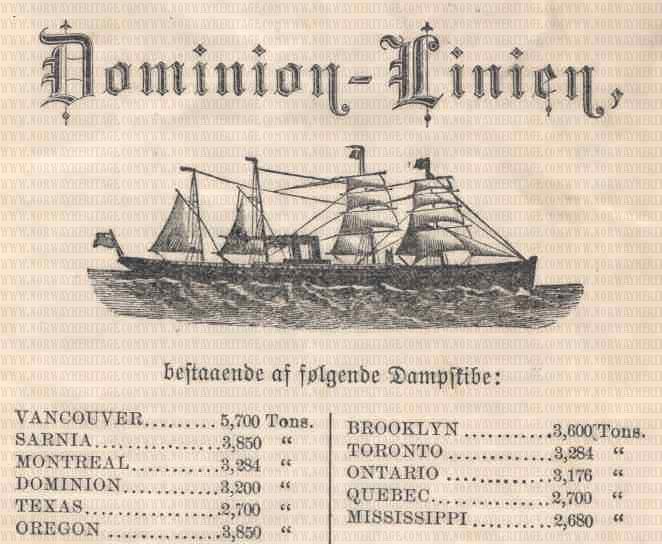 This ad comes from a very interesting traveler's book from 1882 called Palmer's European Pocket Guide with Telegraph Code for Travelers:
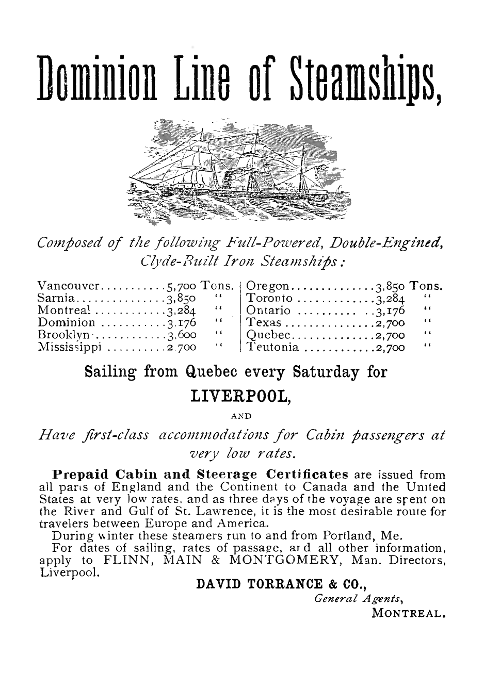 Some image of logos, etc. from Steamship China Collector (now unfortunately no longer existing): 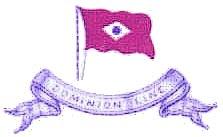  NEW! An actual artifact from the Dominion Line series of china from The Flying Tiger Antiques: 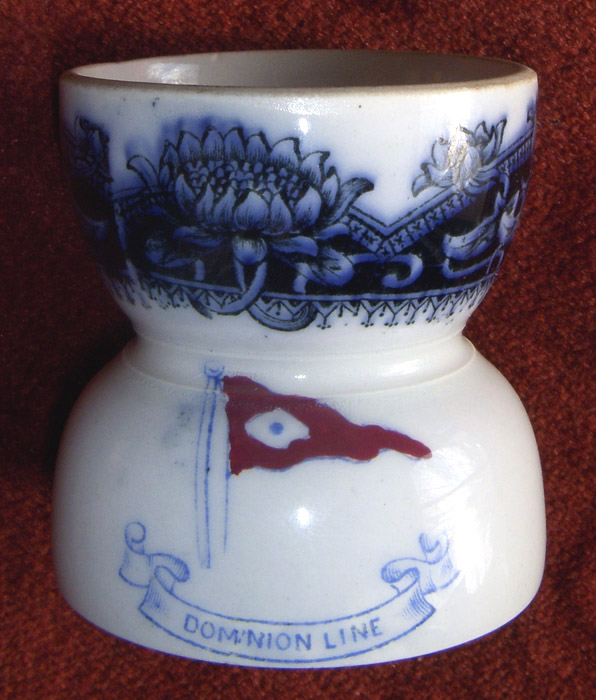 [1888] QUEBEC, ex. HELLESPONT, ex.
CITY OF DUBLIN Code letters: VWHQ Official
Number: 48807 Rigging: iron single screw steam
Bark; 3 decks; partial Shade Deck; 6 cemented
bulkheads Tonnage: 2,621 tons gross, 1,991 under
deck and 1,732 net Dimensions: 318 feet long,
36.3 foot beam and holds 29.5 feet deep; Poop 80
tons; Forecastle 24 tons Construction: 1864,
Smith & Rodger in Glagow Propulsion:
compound engine with 2 inverted cylinders of 46
& 78 inches diameter respectively; stroke 42
inches; operating at 55 p.s.i.; 300 horsepower;
new engine & boilers in 1873; engine built
by Laird Bros. in Birkenhead Owners: Mississippi
& Dominion Steam Ship Co. Ltd. Port of
registry: Liverpool [Gilbert
Provost - from his research using
Lloyd's Register -- much thanks!] Grey River
Argus 1890/04/02
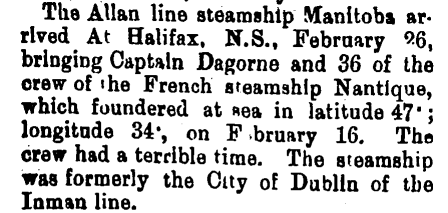 Montreal Herald 1890/03/01
The Press
1890/02/27
Corunna Journal
1890/03/06
[1902] J. Pierpont Morgan started consolidating his
shipping activities. A new conglomerate came into
existance under the name of International Mercantile
and Marine Company. Through this holding, J. Pierpont
Morgan not only controlled the International
Navigation Company of New Jersey (with the Red Star
Line) but also the International Navigation Company of
New Jersey, the International Navigation Company of
Liverpool, as well as other shipping lines, such as
the White Star Line, the Atlantic Transport Line, the
Dominion Line, and the Leyland Line. The total fleet
comprised 133 units. Red Star Line From the Mystic
Seaport database, here are the search results
showing the history of this ship: City of Dublin:
Quebec:
Nautique:
Note: A similar search can be made on the same site
for the history of individual captains, including John
Thomas Thearle, including his function as Master of
the SS Quebec in 1876: Thearle
- Quebec (steamer). |
||||||||||||||||||||||||||||||||||||||||||||||||||||||||||||||||||||||||||||||||||||||||||||||||||||||||||||||||||||||||||||||||||||
HANSA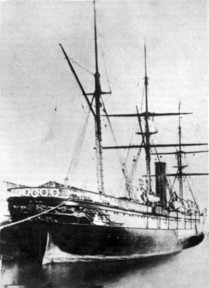 NEW! From a free Ancestors.com
weekend on Labor Day 2013, I found out another tidbit:
the name of the small steamship that brought the Ens
family from Hamburg, Germany to (presumably) Grimsby,
England -- which was then followed by the ocean voyage
to Canada from Liverpool. The ship was named Hansa.
The captain at this time was
named 'Brandt':
The steamship EPTANISOS was built under Lloyd's Register of Shipping Special Survey for the Anglo-Greek Steam Navigation & Trading Co by Richardson, Duck & Co, Stockton-on-Tees, and was launched in February 1865. 747/588 tons (gross/net); 198.8 x 29.1 x 16.7 feet (length x breadth x depth of hold); iron construction, screw propulsion. On 12 April 1867, the EPTANISOS was purchased from Richardson by the Hamburg firm of H. J. Perlbach & Co, and renamed HANSA. The HANSA ex EPTANISOS was sunk on 7 April 1892, after a collision, off the Dutch coast. Here and here are some other links. |
||||||||||||||||||||||||||||||||||||||||||||||||||||||||||||||||||||||||||||||||||||||||||||||||||||||||||||||||||||||||||||||||||||
SS PERUVIAN 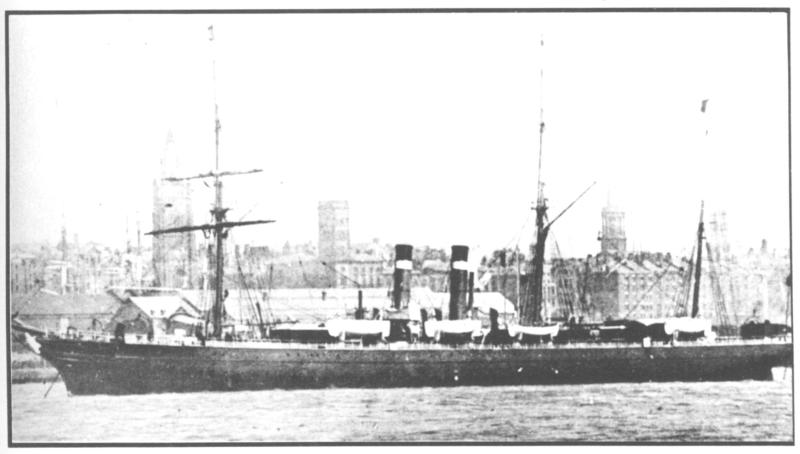 (the ship that brought Jacob & Katherina Ginter (and family) to Canada in June 1875)For a
direct link to an HTML page that contains the other
passengers on the same voyage, see this
link.
The ship that brought the Ginter family over to Canada from Russia was the "SS Peruvian". General information on the ship and the line(s) to which it belonged are described below. The ship docked in Quebec on July 13/1875. It was the 30th ship arriving in Quebec in 1875. The captain of the SS Peruvian during this time was Captain Smith. The leaders of the group were Johann Mueller, Johann Wiebe, Johann Gerbrand and Johann Enns. The origin of the group was the Chortitza and Bergthal colonies in south Russia. Now for the general information about this ship and its line... Built by R.Steele & Co, Greenock in 1863 for the Allan Line, she was a 2549 gross ton ship, length 312.1ft x beam 38.6ft, clipper stem, one funnel, three masts, iron construction, single screw and a speed of 11 knots. There was accommodation for 100-1st class and 600-3rd class passengers. An attempted launch was made on 21st Aug. 1863 but she stuck on the slipway and the launch was completed on 31st Aug. 1863. She sailed from Liverpool on her maiden voyage to Portland on 31st March 1864 and commenced her first run from Liverpool to Quebec and Montreal on 12th May 1864. First voyage from Liverpool to Halifax, Norfolk and Baltimore commenced 11th Aug. 1871. In 1874 she was lengthened to 373.1ft, 3038 tons and her engines compounded, and on 14th July 1874 resumed the Liverpool - Quebec - Montreal service. On 26th April 1887 resumed Liverpool - Baltimore service and in 1890-1891 was fitted with new compound engines and given a second funnel. Commenced a Glasgow - Boston service on 6th Feb. 1891 and a Glasgow - New York service on 9th June 1893. She commenced her last voyage from Glasgow - New York on 7th Dec. 1894 and resumed Glasgow - Boston run on 18th Jan. 1895. On 6th May 1902 she started a Liverpool - St.Johns NF - Halifax run, starting her last voyage on 7th Nov. 1903 and was finally scrapped in Italy in 1905. [North Atlantic Seaway by N.R.P.Bonsor.vol.1, p.310] [ShipsList and Norway Heritage]  |
||||||||||||||||||||||||||||||||||||||||||||||||||||||||||||||||||||||||||||||||||||||||||||||||||||||||||||||||||||||||||||||||||||
|
Other ships
that brought my ancestors to Canada include:  SS Canadian (Allan Line) [brought Diedrich & Helena Thiessen, and Johann & Anna Wolf (and daughter Anna, who married Johann Ginter), and Peter & Elizabeth Hamm and Peter & Helena Heide July 19/1875] The CANADIAN owned by
the Allan
Line was a 2,911 gross ton ship built by
T.Royden & Sons, Liverpool in 1872. Her details
were - length 349.9ft x beam 35.6ft, one funnel,
three masts, iron construction, single screw and a
speed of 11 knots. There was passenger accommodation
for 25-1st and 850-2nd class. Launched in August
1872, she sailed from Liverpool on her maiden voyage
to Quebec and Montreal on 23/8/1873. On 2/12/1873
she commenced her first Liverpool - St John's NF -
Halifax - Baltimore voyage and on 14/5/1874 started
her first Glasgow - Quebec - Montreal crossing. She
inaugurated a Glasgow - Montevideo - Buenos Aires
service for the Allan Line when she sailed from
Glasgow on 11/11/1876 and in 1882 was chartered as a
troopship for the Egyptian Expedition. Her first
Glasgow - Boston sailing started on 21/5/1884 and
her first Glasgow - Philadelphia sailing on
25/6/1884. She left Glasgow on her last North
Atlantic voyage on 1/10/1891 and her last Glasgow -
S.America voyage on 22/9/1902. She was scrapped the
following year. [North Atlantic Seaway by
N.R.P.Bonsor, vol.1,p.314] [The
Ship List]
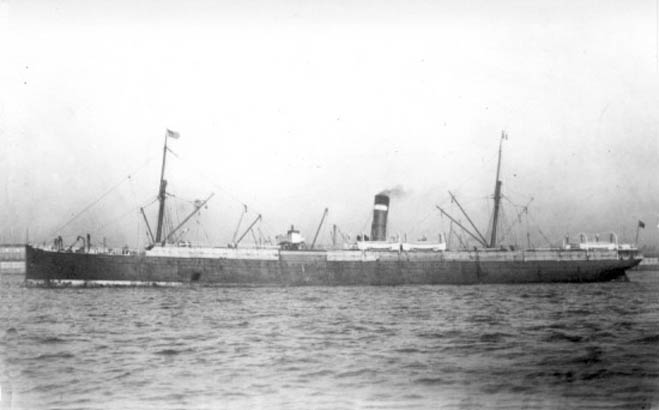 SS Sardinian (Allan Line) [brought Johann Ginter (single at this time) July 30/1876] The SARDINIAN was built
by R.Steele & Co, Greenock in 1874 for the Allan
Line. She was a 4,399 gross ton ship, length
400ft x beam 42.3ft, straight stem, one funnel,
three masts, iron construction, single screw and a
speed of 13 knots. There was passenger accommodation
for 120-1st and 850-3rd class. Launched on 3rd June
1874, she sailed from Liverpool on her maiden voyage
to Quebec and Montreal on 29th July 1875. On 10th
May 1878 she had an explosion in her bunkers at
Moville, Ireland, followed by a fire. She was
scuttled to extinguish the fire but subsequently
refloated and repaired and resumed sailings between
Liverpool, Quebec and Montreal on 27th June 1878. In
1897 she was fitted with triple expansion engines by
Wm.Denny, Dumbarton and one of her masts removed and
on 19th June 1897 commenced her first voyage from
Glasgow to Quebec and Montreal. On 16th Dec. 1897
she started her first Glasgow - New York sailing and
commenced her last voyage on this route on 20th Dec.
1902. She started sailings between London - Quebec
and Montreal, with 2nd and 3rd class passengers only
on 20th May 1905 and on 31st July 1912 commenced
Glasgow - Liverpool - Philadelphia sailings. Between
27th May 1914 and 7th Dec. 1914 she ran between
Glasgow and Boston and in 1917 went to Canadian
Pacific Ocean Services together with the rest
of the Allan Line fleet. On 20th Sept. 1918 she
commenced her first voyage for her new owners when
she left London for Quebec and Montreal and on 24th
Nov. 1918 made her first voyage after the Armistice,
from Glasgow to St John NB with cargo only. She
commenced sailings between Avonmouth - Quebec and
Montreal on 17th May 1919 and started her last
voyage from Avonmouth to St John NB on 21st Dec.
1919. She was sold on 8th Dec. 1920 and became a
hulk at Vigo. On 22nd June 1938 she was towed to
Bilbao and scrapped. [North Atlantic Seaway by
N.R.P.Bonsor, vol.01,p.314] [The
Ship List]
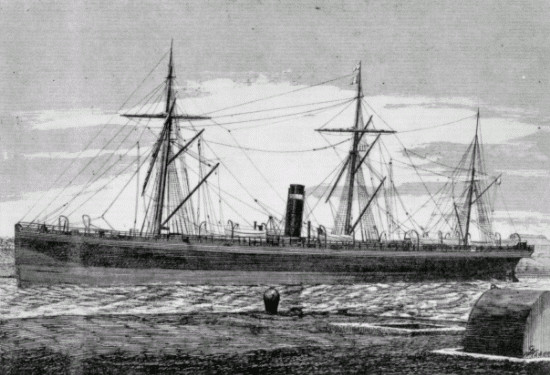 The POLYNESIAN was
built by R.Steele & Co, Greenock in 1872 for the
Montreal
Ocean SS Co. She was a 3,983 gross ton ship,
length 400ft x beam 42.5ft, straight stem, one
funnel, three masts (rigged for sail), iron
construction, single screw and a speed of 13 knots.
There was accommodation for 120-1st and 850-3rd
class passengers. Launched on 12th Feb. 1872, she
sailed from Liverpool on her maiden voyage to Quebec
and Montreal on 3rd. Oct. 1872. She started her last
voyage on this service on 23rd July 1891 and on 8th
Dec. 1891 commenced the first of two round voyages
between Liverpool and Baltimore. In 1893 she was
rebuilt to 4,522 gross tons, fitted with
triple-expansion engines by Workman, Clark &
Co., Belfast, one mast removed and given
accommodation for 36-1st and 1,000-3rd class
passengers. Renamed LAURENTIAN, she resumed
Liverpool - Quebec - Montreal sailings on 27th April
1893. On 31st August 1899 she commenced her first
Glasgow - New York voyage and started her last
voyage on this route on 10th Feb. 1905. She started
her first Glasgow - Boston sailing on 17th March
1905 and her first Glasgow - Philadelphia voyage on
22nd April 1905. In 1906 she was refitted to carry
2nd and 3rd class passengers only and on 20th August
1909 made her last Glasgow - Boston sailing. She was
wrecked at Trepassey Bay, Newfoundland on 6th Sept.
1909 with no loss of life. [North Atlantic Seaway
by N.R.P.Bonsor, vol.1,p.314] [The
Ships List]
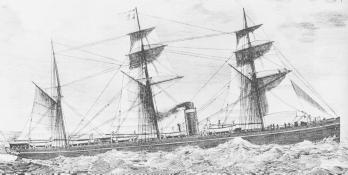 SS
Sarmatian
(Allan Line)
[brought Jacob & Maria Fehr July 6/1875] The SARMATIAN was a
3,647 gross ton ship, length 370.9ft x beam 42.2ft,
one funnel, three masts (rigged for sail), iron
construction, single screw and a speed of 13 knots.
There was accommodation for 100-1st and 850-3rd
class passengers. Built by R. Steele & Co,
Greenock (engines by Macnab & Co, Greenock), she
was launched for the Allan
Line on 7th Mar.1871. Her maiden voyage
started on 31st Aug.1871 when she sailed from
Liverpool for Quebec and Montreal and 1874 she was
chartered for use as a troopship for the Ashanti
Expedition. Her last voyage from Liverpool started
on 3rd Jan.1889 when she sailed for Halifax and
Portland and on 21st Jun.1889 she commenced her
first Glasgow - Quebec - Montreal sailing. Fitted
with triple expansion engines in 1890, she resumed
Glasgow - Quebec - Montreal sailings on 25th
Apr.1890. In 1900 her accommodation was
re-classified as 2nd and 3rd class only and on 3rd
Jun.1903 she commenced her first Glasgow - Boston
voyage. Her first London - Quebec - Montreal sailing
started on 22nd Apr.1905 and her final sailing
started on 20th Jul.1907 when she left Boston for
Glasgow. In 1908 she was scrapped at
Rotterdam.[North Atlantic Seaway by N.R.P.Bonsor,
vol.1,p.313-4] [The
Ships List]
This ad comes for the Allan Line from a very interesting traveler's book from 1875 called A Graphic Description of the Dominion of Canada and its Provinces: 
[brought John
&
Katherina
Hoeppner June 23/1876, and Peter
&
Elizabeth
Penner June 23/1876 (his parents) as
well]
(detail above) The QUEBEC was built by Smith & Rodger, Glasgow. She was a 2,138 gross ton ship, length 318ft x beam 36.3ft, clipper stem, one funnel, three masts (rigged for sail), iron construction, single screw and a speed of 11 knots. Laid down for British owners as the HELLESPONT, she was bought on the stocks by the Inman Line of Liverpool and launched in February 1864 as the CITY OF DUBLIN. She started her maiden voyage on 10/12/1864 when she left Liverpool for Queenstown (Cobh) and New York. Her last voyage on this service commenced 2/4/1872 and she was then purchased by the Dominion Line of Liverpool, and fitted with compound engines by Laird Bros, Birkenhead. She started a single round voyage between Liverpool and Boston on 19/2/1874 and was then renamed QUEBEC. She commenced Liverpool - Quebec - Montreal voyages on 16/4/1874 and started Avonmouth - Quebec - Montreal sailings on 30/4/1886. Her last voyage between Avonmouth, Swansea and New York started on 16/12/1887 and in 1888 she was sold to French owners and renamed NAUTIQUE. On 16/2/1890 she was abandoned and lost in the North Atlantic. [North Atlantic Seaway by N.R.P.Bonsor, vol.1,p.241] [The Ships List] ????
[brought Jacob & Anna Thiessen 1892] I continue to have no
idea what ship brought this family to Canada.
This
page contains entries for the unusual 1892 migration
year:
This page offers some suggestions for candidates, but ultimately cannot provide a solution, for the reasons mentioned :( NEW! Thanks to Andrea of BallinStadt, I now know that the 'SS Warrington' brought the Thiessen family from Hamburg, Germany to Grimsby, England on July 29, 1892! The captain was named 'Green', the ship was a 'steamship', and it flew the flag of England. However, I have been unable to determine which ship brought them from Liverpool, England to Canada. The 'SS Warrington' was part of the 'Manchester, Sheffield, and Lincolnshire Railway Company' feeder line, built in 1886 and wrecked in 1903. The Thiessen family was from the village of Burwalde (Chortitza colony) in Russia, and was destined for Gretna, Manitoba, Canada. Here is an article Marine Engineer and Naval Architect, Volume 8, 1887: 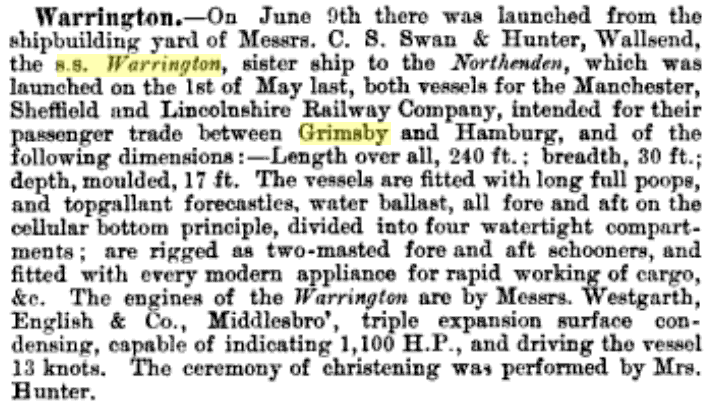 Here is an ad for the Great Railway Company, which later owned the 'SS Warrington':  THE
JOURNEY
There are no personal stories to be told of the ocean voyages of my ancestors directly, but there are plenty of images and anecdotes from other immigrant steamship journeys of that era, and most are very unpleasant. The 'good news' was that steamships were much faster than sailing ships, and this reduced the travel time from 6-8 weeks down to 10-12 days! It would seem that the Mennonites traveled as 3rd-class passengers i.e. "steerage class':  The Canadian
Government printed useful immigration
booklets annually, with good practical advise
on preparation for the journey, and life in Canada
upon arrival:
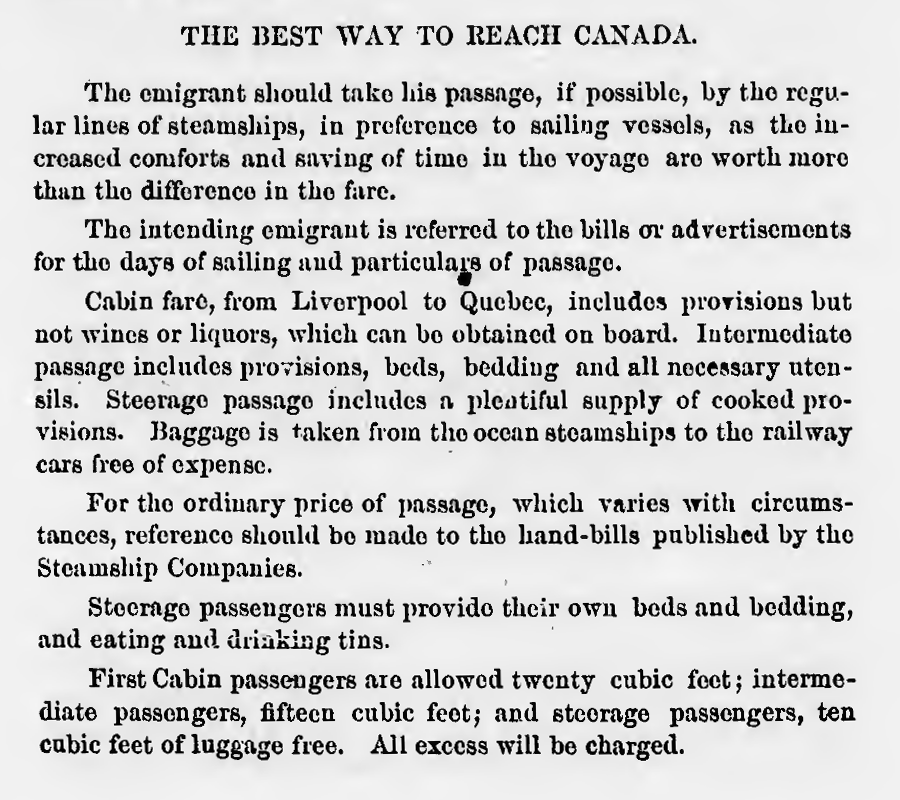 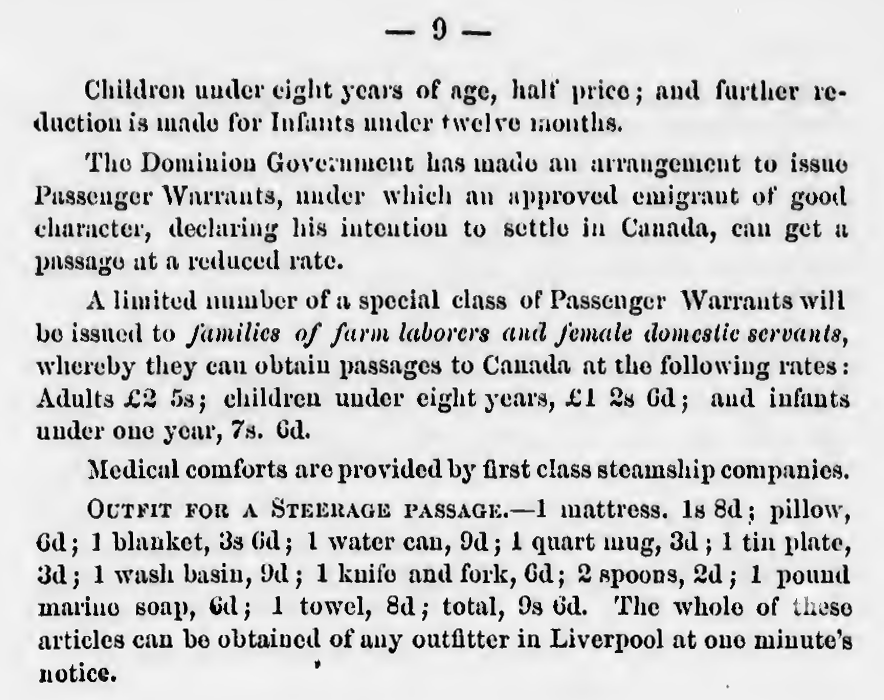 One
mystery is whether food was prepared for the
steerage-class Mennonite travelers, or if instead
food and cooking supplies were provided? For
'intermediate' passengers, here is an example of a
interesting but simple 'Bill
of Fare' (menu) for the time (1883):
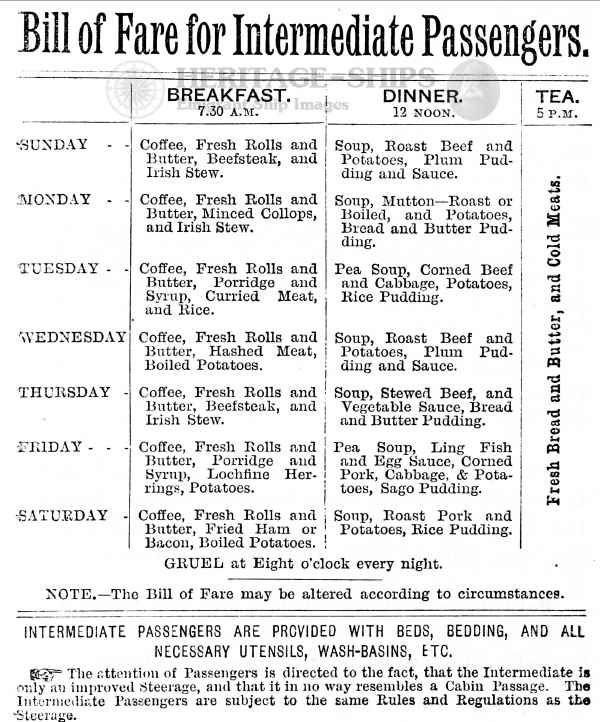 In
contrast, steerage-class passengers appeared
to have less meat as part of their
fare. Here is another account of life
on the Inman line for steerage passengers (Hartford
Weekly Times, Aug 11, 1881):
 Here is another very interesting account of life in steerage class: A young man who crossed in the last year described his fare to the writer, thus : " At breakfast," he said, " we usually had oatmeal porridge and molasses, with coffee in plenty, rolls and butter. This was varied by bash instead of porridge on some days, or perhaps an Irish stew ; but fresh baked rolls and butter were always in abundance. There was always soup at dinner, and some boiled beef, pork, or fish, with potatoes and bread. Supper did not amount to much, but there was plenty of plain, good stuff to eat. Roast beef and plum duff were served at Sunday's dinner." This food was served to the passengers by stewards, but there was no placing of dishes opposite the passenger's plate. The general meal was set down in the middle of the table, and "help yourself " was the order of the day. The passengers do not cook their own food now, but they have to provide their own cups, plates, and other utensils, as well as their own bedding. All captains of
passenger steamships are scrupulously attentive to
the needs of their passengers. Not a day passes that
they do not make a personal inspection of this
department, and they are always approachable in the
event of complaints arising on the part of the
poorest travelers. [Procedures
for processing Immigrants onboard Steamships -
Ocean Passenger Travel] This is the scene that would have greeted my ancestors as they arrived in Quebec around the time of the migrations: 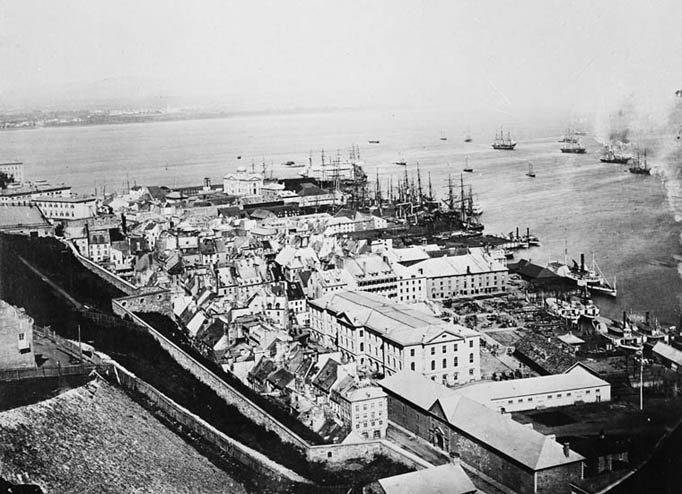 This is the scene that would have greeted my ancestors as they passed Montreal:  Here is part of of a traveler's book for 1876 with calendar and political information:  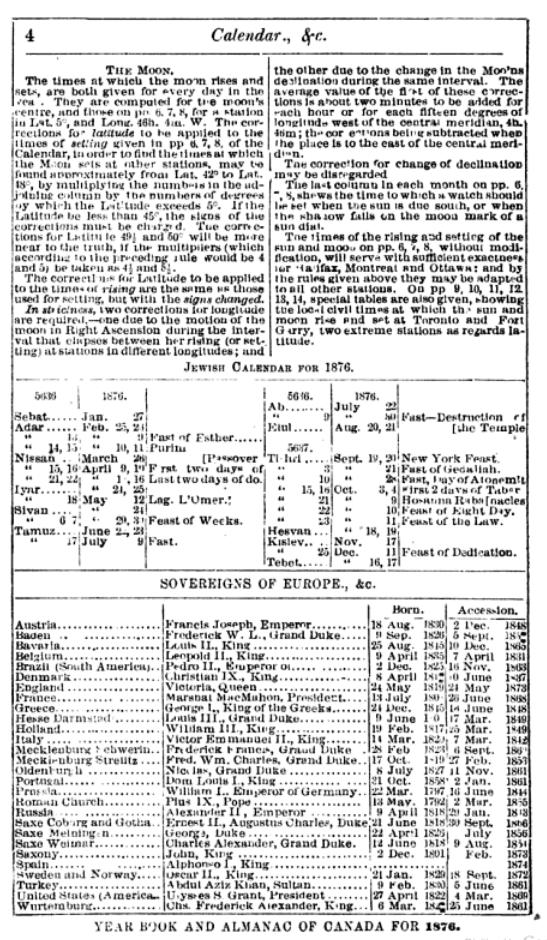 |
| Here is an interesting page from the Journals of the House of Commons of the Dominion of Canada, Volume 10 discussing the reservation of land for Mennonites in 1876: Some attempts to interpret the photocopies of microfilms of the original land grant applications made before the actual land grant was made in 1886:
Thanks go to the Morden
Land Titles Office for providing
access to the original land grant documents (just
before being moved and put into non-public storage
forever!). The Canada ArchiviaNet
Western Land Grants also has an image
of
the land grant deed available!
Similarly, Library
and Archives Canada has a searchable Land
Grants of Western Canada, 1870-1930 which
then links directly to the Franz
Ens 1886 land deed! |
Maps related to the History of the Enns FamilyInitial Mennonite migration from Vistula Delta,
Prussia to Chortitza Colony, Russia (© Mennonite
Heritage Centre, Winnipeg, Manitoba): Mennonite colonies of southern Russia (© Mennonite Heritage Centre, Winnipeg, Manitoba): Bergthal daughter colony in which Franz Ens was
born (© Mennonite Heritage Centre, Winnipeg,
Manitoba): Nue-Osterwick village in Chortisa colony from
which Franz Ens and wife Justina originated (©
Mennonite Heritage Centre, Winnipeg, Manitoba): Fuerstenland daughter colony from which Franz Ens and wife Justina emmigrated from (© Mennonite Heritage Centre, Winnipeg, Manitoba): This map comes from a
very interesting traveler's book from 1882 called
Palmer's
European Pocket Guide with Telegraph Code for
Travelers: Map
of Manitoba West
Reserve (© Mennonite Heritage
Centre, Winnipeg, Manitoba):
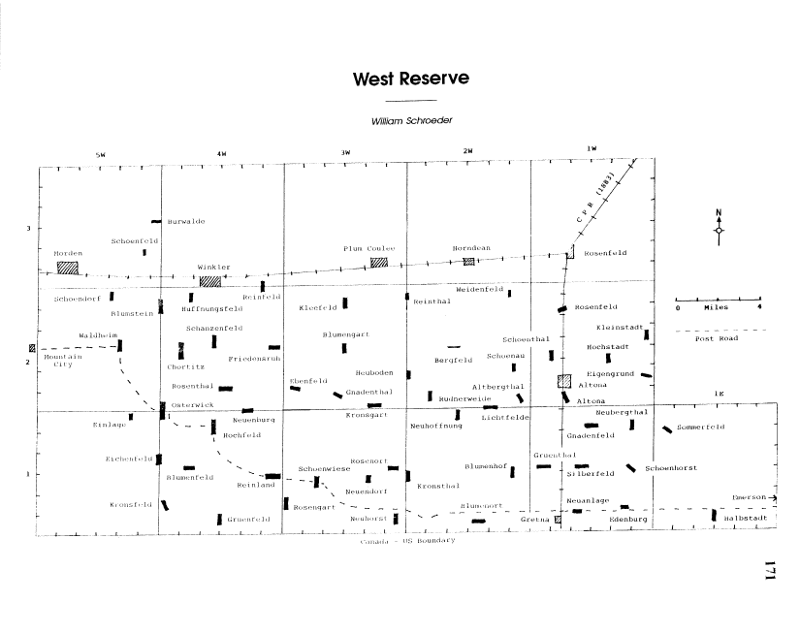 Another good map of Manitoba West Reserve with markers for original villages (© Ernest Unrau at Kronsfeld Cemetary Memorial Project): 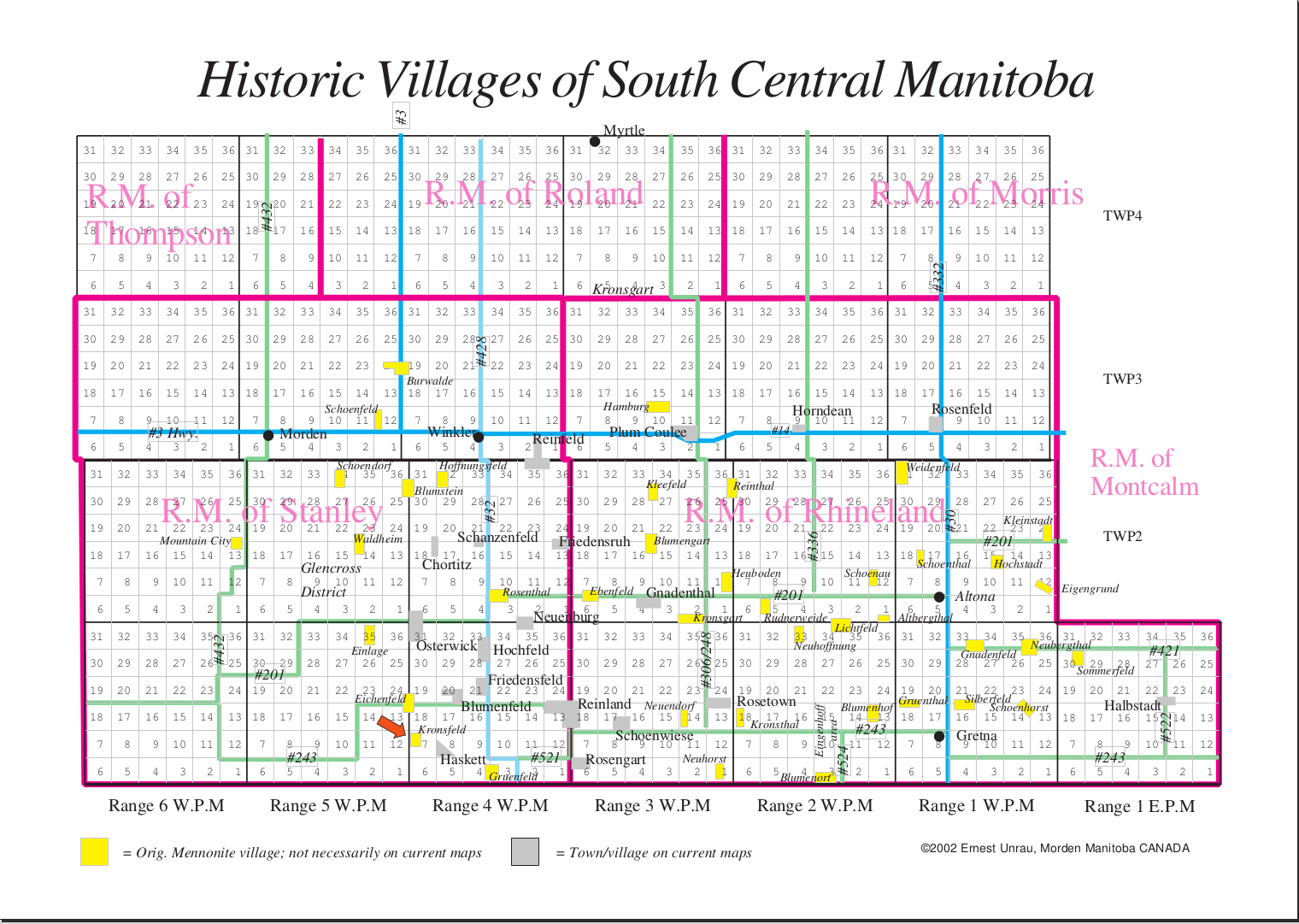 Village map of Eichenfeld where Franz and Justina first lived in Manitoba -- linked to the Manitoba homestead land grants in Township 1 Range 5 & 4 W1 (south of Morden) they migrated to (generated with the graphviz program package): To see my generated homestead maps
generated from the Canada
ArchiviaNet
Western Land Grants (1870-1930) site, use
the image-clickable map below i.e. click on one of
the township (1,2,3) and range (I,II,III,IV,V,VI)
squares: 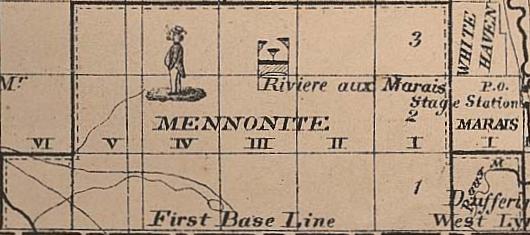 This will then present a
generated Township/Range map of the square
selected, which you can then further click the
desired Section to jump to a Library and
Archives Canada page containing a link. NOTE
2:
There is no claim to the accuracy of the
generated maps. This is just my own humble
attempt to convert the textual information on
the database to a visual format. For a nice historical map showing south-central Manitoba in 1876 (same year that Franz Enns family arrived), click this link. A small piece of this map is shown above. These maps came from the Halton Hills Public Library, but the original links are dead :( |
 |
| This website dedicated to the
memory of my father, Jacob Abram Enns
(1939-2004). He often accompanied me on my
genealogical research journeys. A page
with more information on this great man can be
found here. Till
we meet again, Dad! |